When it comes to the state of Texas, it is home to a diverse range of avian species. From majestic eagles and hawks to tiny warblers and hummingbirds, there is no shortage of varieties to admire.
Among the numerous types of birds that reside in Texas, small birds hold a special place in the hearts of bird lovers. Despite their diminutive size, these birds exhibit an astonishing array of colors, patterns, and behaviors.
With their delicate songs and quick movements, small birds bring joy and beauty to the Texas landscape. Here, we’ll explore some of the common small birds found in the state, along with a few fascinating facts about each of them.
1. Northern Cardinal

The Northern Cardinal is a beautiful bird, easily identified by its bright red plumage. It can be found in the eastern United States from Maine to Minnesota and south through Mexico and Belize.
Along with its striking colouration, it has a distinctive crest on its head and sharp black facial markings around the eyes.
Despite their small size (measuring 7-9 inches) they are very vocal birds – males sing persistently throughout springtime to attract mates or proclaim their territory.
They typically feed on insects, seeds and fruits but also enjoy suet at backyard bird feeders.
The female is less brightly coloured than her mate but still stands out among other songbirds due to her warm brownish-red feathers.
Cardinals pair for life so you may often see them together in your garden or neighbourhood park.Scientific classification:
| Kingdom | Animalia |
| Phylum | Chordata |
| Class | Aves |
| Order | Passeriformes |
| Family | Cardinalidae |
| Genus | Cardinalis |
| Species | C. cardinalis |
Also Featured In: Most Common United States Birds, Birds for Your Home Garden
2. Northern Mockingbird
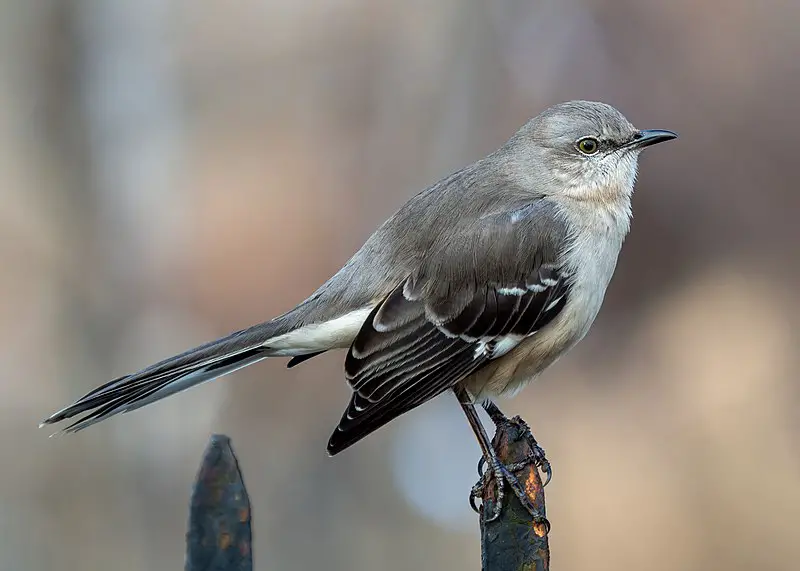
The northern mockingbird is a common fixture in North American skies. It has greyish-brown upperparts and a paler underside with white wing patches, and its distinctive long tail makes it easy to spot.
This adaptable bird can often be seen singing from the tops of trees or fences, though it rarely strays into Europe.
The species was first described by Carl Linnaeus in his 1758 Systema Naturae as Turdus polyglottos – aptly named for their remarkable ability to mimic other birds’ songs.
Northern mockingbirds typically live on insects, fruits, berries and seeds but they will also happily scavenge food scraps left out by humans.
With its beautiful song and striking plumage this beloved avian makes an important contribution to our environment.Scientific classification:
| Kingdom | Animalia |
| Phylum | Chordata |
| Class | Aves |
| Order | Passeriformes |
| Family | Mimidae |
| Genus | Mimus |
| Species | M. polyglottos |
Also Featured In: Most Common Winter Birds, Birds that Live in San Francisco Bay Area
3. American Goldfinch
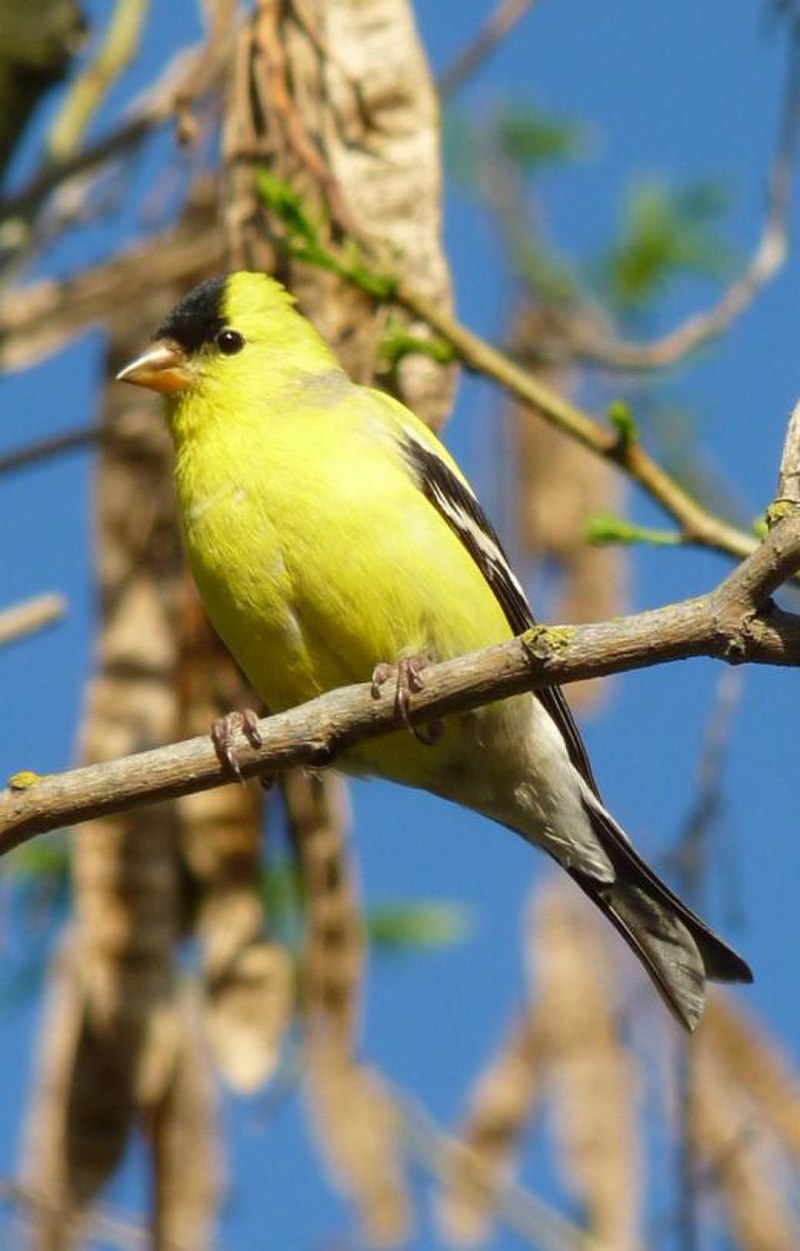
The American goldfinch is a small North American bird in the finch family. Males are vibrant yellow with black wings and tail, while females are duller in colouration.
It migrates from mid-Alberta to North Carolina during breeding season, south of Canada–United States border to Mexico for its wintering grounds.
The only finch which undergoes complete molt every year, it displays sexual dichromatism where males have brighter colours than their female counterparts.
They feed mainly on seeds but also eat insects such as aphids and caterpillars when raising youngs; they often occur near thistles or other plants that produce viable seed heads.
Their call consists of an array of chirps and trills making them quite conspicuous.Scientific classification:
| Kingdom | Animalia |
| Phylum | Chordata |
| Class | Aves |
| Order | Passeriformes |
| Family | Fringillidae |
| Subfamily | Carduelinae |
| Genus | Spinus |
| Species | S. tristis |
Also Featured In: Common Central Park Birds, Most Common Nature Birds
4. Songbirds
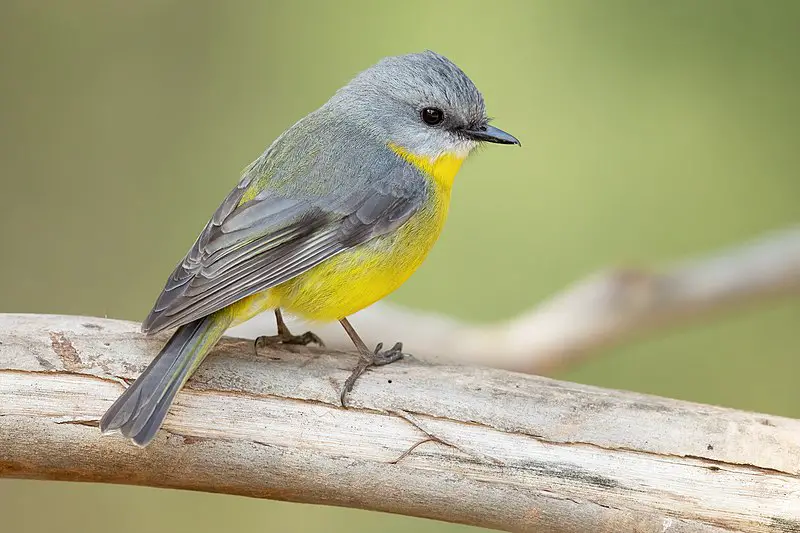
Songbirds are a special suborder of perching birds found all over the world. These beautiful creatures have intricate vocal organs that allow them to produce elaborate bird songs, making them stand out from other species.
With around 5,000 different types of songbird in existence, they come in various sizes and colors with complex feathers adding to their beauty.
Songbirds play an important role in eco-systems as they help disperse seeds by eating fruit and insects which act as agents for pollination.
Their presence also serves to attract more biodiversity into areas where these delicate animals live, creating vibrant habitats full of life.Scientific classification:
| Kingdom | Animalia |
| Phylum | Chordata |
| Class | Aves |
| Order | Passeriformes |
| Clade | Eupasseres |
| Suborder | Passeri Linnaeus, 1758 |
Also Featured In: Famous Paintings Birds, Common Birds in the Cities
5. Bluebirds
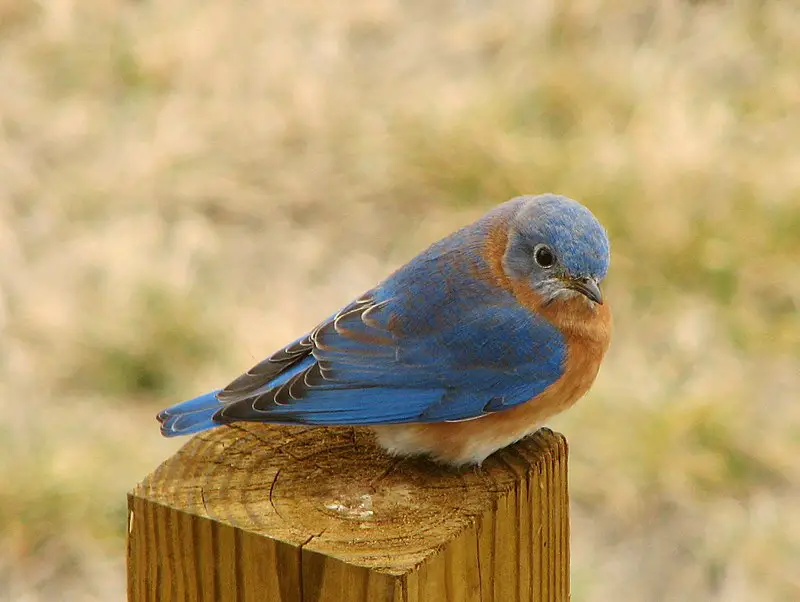
Bluebirds are a North American species of small to medium-sized birds belonging to the thrush family. They have stunning blue and rose beige plumage, with males having brighter colors than females.
These beautiful birds mainly feed on insects, but they can also eat some fruits or seeds from time to time. Bluebirds reside in open fields, meadows and backyards across much of North America.
Their cheerful songs bring joy as they fly through their habitats looking for food during the day before returning home at nightfall.
The sight of these beautiful creatures is often associated with happiness and hope – making them beloved by many people.Scientific classification:
| Kingdom | Animalia |
| Phylum | Chordata |
| Class | Aves |
| Order | Passeriformes |
| Family | Turdidae |
| Subfamily | Myadestinae |
| Genus | Sialia Swainson, 1827 |
Also Featured In: Birds of Symbolism, Spiritual Birds
6. Wrens
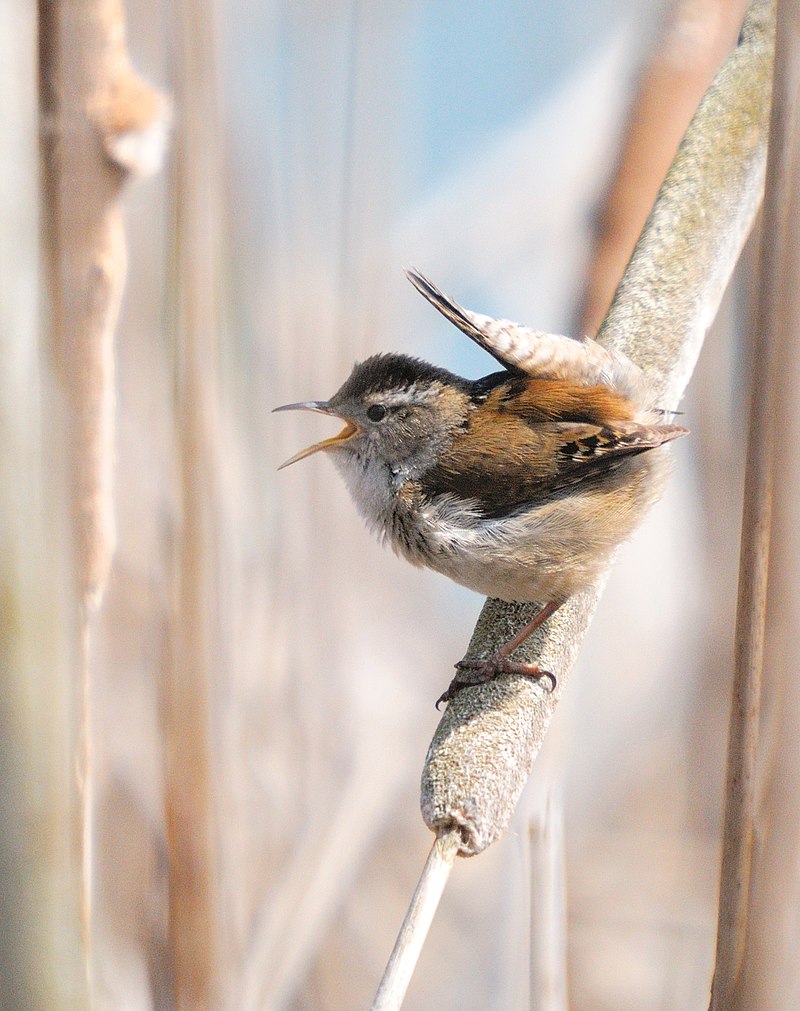
Wrens are a family of small brown passerine birds found mainly in the Americas. They are considered one of the most abundant bird species, with 88 known varieties divided into 19 genera.
The Eurasian wren is the only type that inhabits Europe and other parts of the Old World, where it’s commonly referred to simply as “wren.”
This species has been given its name due to similar-looking unrelated birds living elsewhere such as New Zealand wrasses.
Wrens have tiny bodies with thin bills and long tails which they often hold upright for hours at a time while singing their loud cheery songs from treetops or low shrubs.
Their diet consists mostly of insects but can also include fruits and seeds depending on availability in their habitat range.Scientific classification:
| Kingdom | Animalia |
| Phylum | Chordata |
| Class | Aves |
| Order | Passeriformes |
| Superfamily | Certhioidea |
| Family | Troglodytidae Swainson, 1832 |
Also Featured In: Common Denmark Birds, Most Common Scotland Birds
7. Eastern Bluebird
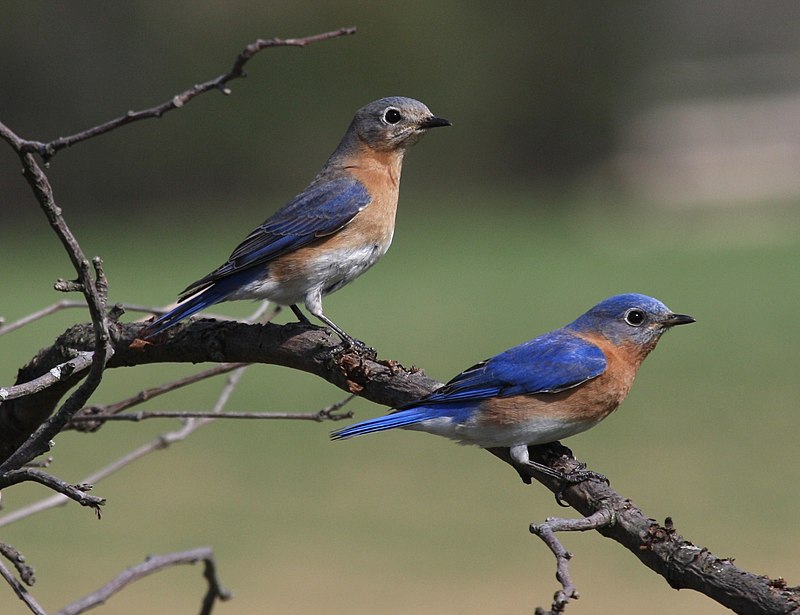
The Eastern bluebird is a small migratory thrush that can be found in open woodlands, farms and orchards across North America.
The male has bright-blue breeding plumage which makes it easily recognizable by birders.
It produces melodious songs such as jeew, chir-wi and chiti WEEW wewidoo.
This popular species was declared the state bird of Missouri back in 1927 due to its beauty and charm.
In addition to being beautiful, these birds are also beneficial for farmers because they eat insects like grasshoppers and beetles which damage crops.
They nest in cavities so providing nesting boxes helps them thrive even more.
With their vibrant colors, sweet melodies and helpful nature it’s easy to see why the Eastern Bluebird is beloved worldwide.Scientific classification:
| Kingdom | Animalia |
| Phylum | Chordata |
| Class | Aves |
| Order | Passeriformes |
| Family | Turdidae |
| Genus | Sialia |
| Species | S. sialis |
Also Featured In: Birds that Migrate through Illinois in the Spring, Birds that Live in Mississippi
8. New World Warblers

New World warblers are an incredibly diverse family of small birds found only in the Americas. They range in size from tiny hummingbirds to large thrushes, and come in a variety of vibrant colors.
All have thin bills made for eating insects which form their main diet. Most species live predominantly arboreal lives, meaning they spend most of their time among trees or bushes searching for food.
However some members such as ovenbirds and waterthrushes prefer more terrestrial habitats like forest floors where they can scavenge for bugs on the ground instead.
Warblers provide a great source of entertainment with their beautiful songs often filling up woodlands during mornings and evenings throughout springtime.Scientific classification:
| Kingdom | Animalia |
| Phylum | Chordata |
| Class | Aves |
| Order | Passeriformes |
| Superfamily | Emberizoidea |
| Family | Parulidae Wetmore et al., 1947 |
Also Featured In: Autumn Birds You Should Know, Common Birds in Alberta
9. Downy Woodpecker
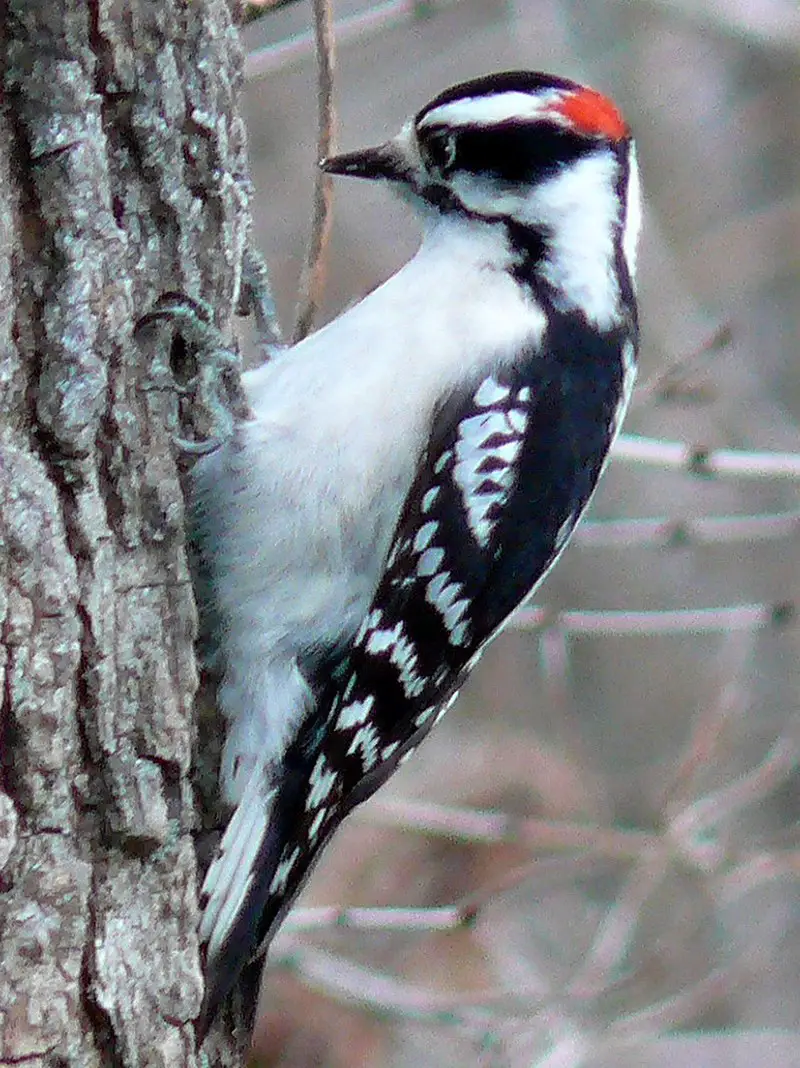
The downy woodpecker is a small species of woodpecker found in North America. Growing up to 7 inches long, it can be identified by its white belly and spotted wings.
It inhabits forests throughout the United States and Canada, with the exception of deserts in the southwest and northern tundra.
This bird nests in tree cavities and feeds mostly on insects but will supplement its diet with fruit or nuts when available.
The Downy Woodpecker has an unmistakable call that sounds like a loud ‘pik-er’, similar to other members of its family such as the Hairy Woodpecker.Scientific classification:
| Kingdom | Animalia |
| Phylum | Chordata |
| Class | Aves |
| Order | Piciformes |
| Family | Picidae |
| Genus | Dryobates |
| Species | D. pubescens |
Also Featured In: Long Island Birds You Should Know, Birds in Calgary You’ll Love to See
10. House Sparrow

The house sparrow is a small bird of the Passeridae family. It has an average length of 16 cm and weighs 24-39.5 gm.
Females have dull brown and grey plumage, whereas males are brighter, with black, white and brown markings on their wings and back feathers.
This species is one among 25 different kinds in its genus Passer .These birds are found all around the world mainly near human dwellings where they feed off food scraps from garbage bins or gardens etc..
They also make nests close to houses which makes them even more visible to people living nearby.
House sparrows can be seen hopping around yards looking for food during daytime hours but usually hide in colonies at night time.Scientific classification:
| Kingdom | Animalia |
| Phylum | Chordata |
| Class | Aves |
| Order | Passeriformes |
| Family | Passeridae |
| Genus | Passer |
| Species | P. domesticus |
Also Featured In: Ukrainian Birds You Should Know, Asian Birds
11. House Finch

The House Finch is a species of finch native to western North America and has been introduced in the eastern half of the continent as well as Hawaii.
It’s an average-sized finch with adults measuring 12.5 – 15 cm (5 – 6 inches) long and having wingspans between 20 – 25 cm (8 – 10 inches).
The upperparts are brown, while its underparts range from pale grayish white to yellow depending on subspecies.
Its face is streaked or spotted with reddish coloration; males typically have brighter plumage than females due to sexual dimorphism.
They’re mostly found near human habitations such as farms and gardens where they feed on grains, fruits, insects etc., making them very popular among birders who want something colorful for their backyard.Scientific classification:
| Kingdom | Animalia |
| Phylum | Chordata |
| Class | Aves |
| Order | Passeriformes |
| Family | Fringillidae |
| Subfamily | Carduelinae |
| Genus | Haemorhous |
| Species | H. mexicanus |
Also Featured In: Common Birds That Live in Las Vegas, Birds That Live around Seattle
12. Common Starling

The Common Starling is a medium-sized passerine bird that belongs to the starling family. It has glossy black plumage with a metallic sheen, and in certain times of year it can be speckled with white.
The bill and legs are typically pink or black depending on the season, while its length measures about 8 inches long.
Its diet consists mainly of insects but also includes small fruits and seeds as well as some human food waste.
They live in large flocks which provides protection against predators, although they can become quite aggressive when defending their nesting sites during breeding seasons.
Overall, this species is highly adaptable and widely distributed across many parts of Europe making them one of the most successful birds in the region today.Scientific classification:
| Kingdom | Animalia |
| Phylum | Chordata |
| Class | Aves |
| Order | Passeriformes |
| Family | Sturnidae |
| Genus | Sturnus |
| Species | S. vulgaris |
Also Featured In: European Birds, Birds in Iowa Spring
13. Mourning Dove
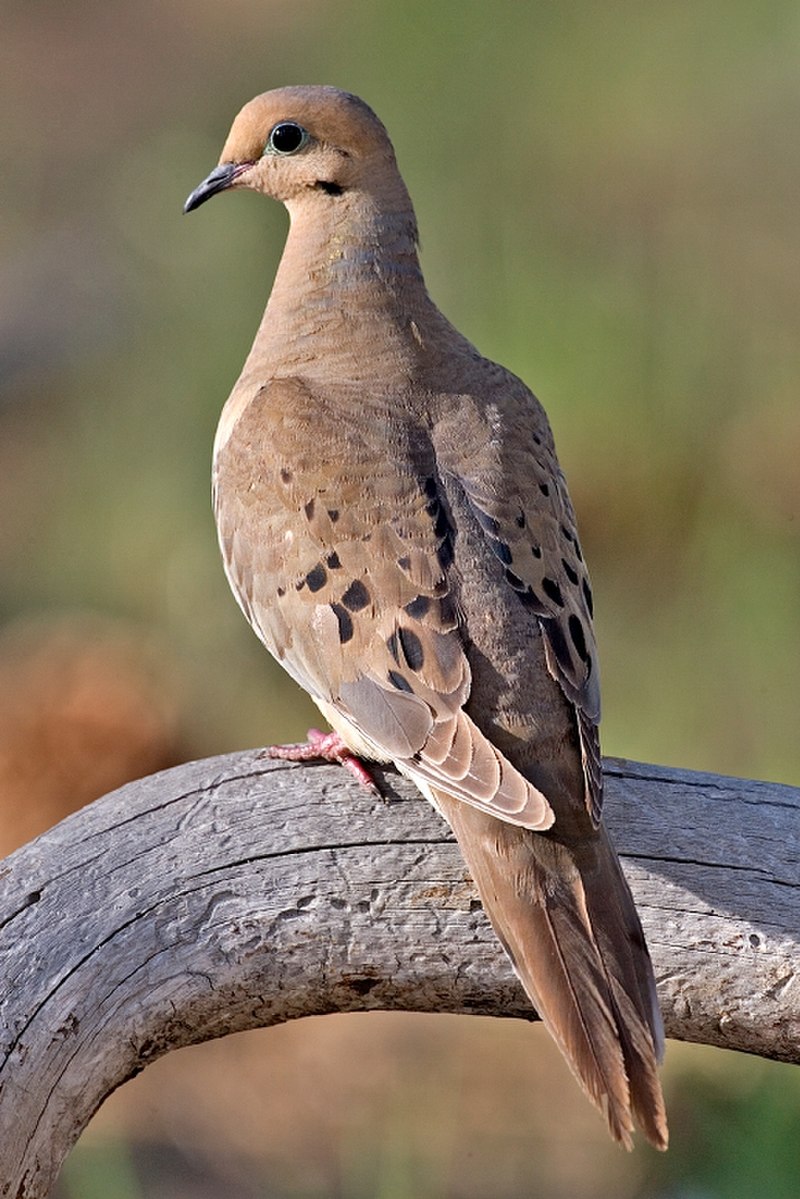
The Mourning Dove is a breathtakingly beautiful bird. It has stunning gray and brown feathers with white tipped wings, giving it an elegant appearance. Its long tail also adds to its graceful look in flight.
A symbol of peace and serenity, they are abundant across North America and can be found in gardens or open fields throughout the year.
As well as being popular game birds for hunters, they feed on grains such as wheat and millet providing important food sources for wildlife species including foxes, coyotes, skunks and raccoons.
These doves have a distinctive cooing sound that can often be heard echoing through woodlands during summer evenings making them one of nature’s greatest treasures.Scientific classification:
| Kingdom | Animalia |
| Phylum | Chordata |
| Class | Aves |
| Order | Columbiformes |
| Family | Columbidae |
| Genus | Zenaida |
| Species | Z. macroura |
Also Featured In: Birds of Nova Scotia, Common Species of Birds
14. Tufted Titmouse

The Tufted Titmouse is a small, cheerful songbird found in North America. It’s part of the tit and chickadee family (Paridae).
It has distinctive white feathers around its eyes, grey-brown wings and upper body, with a pale tan underside.
Its most notable feature is the black crest on top of its head that gives it an inquisitive look. The male also sports a pinkish breast which can be seen.
When singing from high perches during the spring months. This bird loves to eat sunflower seeds or suet at backyard feeders as well as insects in summertime.
You may even see them poking into crevices and bark looking for food.
They are quite social birds too, being often spotted in mixed flocks alongside other species such as nuthatches and woodpeckers all year round.Scientific classification:
| Kingdom | Animalia |
| Phylum | Chordata |
| Class | Aves |
| Order | Passeriformes |
| Family | Paridae |
| Genus | Baeolophus |
| Species | B. bicolor |
Also Featured In: Birds that Calls in the Morning, Common Birds of Houston
15. Red-Winged Blackbird

The red-winged blackbird is a beautiful bird found in most of North America and Central America.
Its distinct features include a glossy black body, with white shoulder patches and bright red wing coverts year round.
It prefers wetland habitats such as marshes, ponds, lakeshores and agricultural fields. During breeding season they inhabit grassy areas near water then move south for the winter months.
For food they mainly eat insects but also consume wild fruit or grains.
They are very social birds often seen in large flocks during migration times when their unmistakable “conk-la-ree” call can be heard echoing across the sky.Scientific classification:
| Kingdom | Animalia |
| Phylum | Chordata |
| Class | Aves |
| Order | Passeriformes |
| Family | Icteridae |
| Genus | Agelaius |
| Species | A. phoeniceus |
Also Featured In: Birds Commonly Found in Northern California, Wetlands Birds You Should Know
16. Carolina Wren
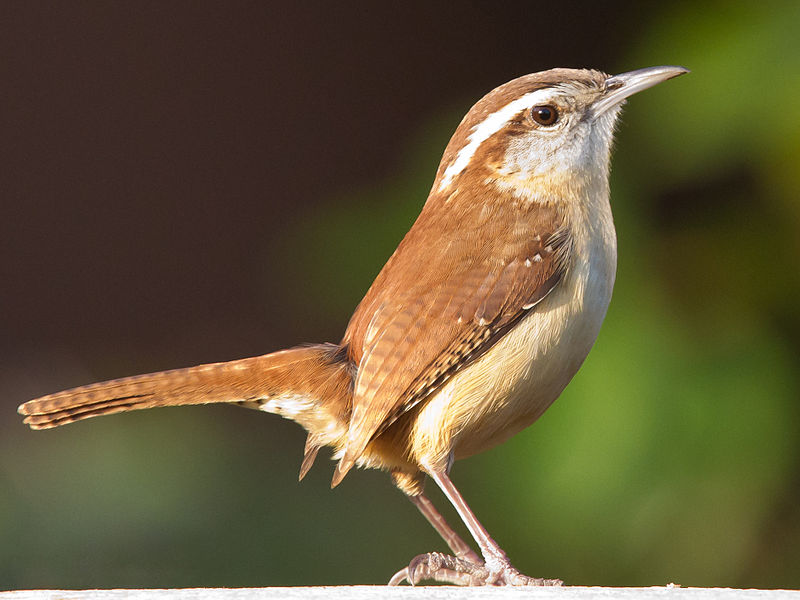
The Carolina wren (Thryothorus ludovicianus) is a medium-sized bird that can be found in the eastern United States, southern Ontario and northeast Mexico.
They typically live in dense shrubbery or thickets near open areas such as gardens, parks and woodland edges.
These birds are quite adaptable when it comes to nesting sites – they will build their nests anywhere from tree cavities to manmade boxes.
Their diet consists of insects, spiders and other invertebrates which they forage for on the ground or among vegetation.
The males have an unmistakable song made up of loud whistles interspersed with trills reminiscent of laughter; you’ll often find these cheerful little birds singing away during early morning hours.Scientific classification:
| Kingdom | Animalia |
| Phylum | Chordata |
| Class | Aves |
| Order | Passeriformes |
| Family | Troglodytidae |
| Genus | Thryothorus Vieillot, 1816[2] |
| Species | T. ludovicianus |
Also Featured In: Birds that can be Seen in Outer Banks, Small Kentucky Birds
17. Black-Chinned Hummingbird
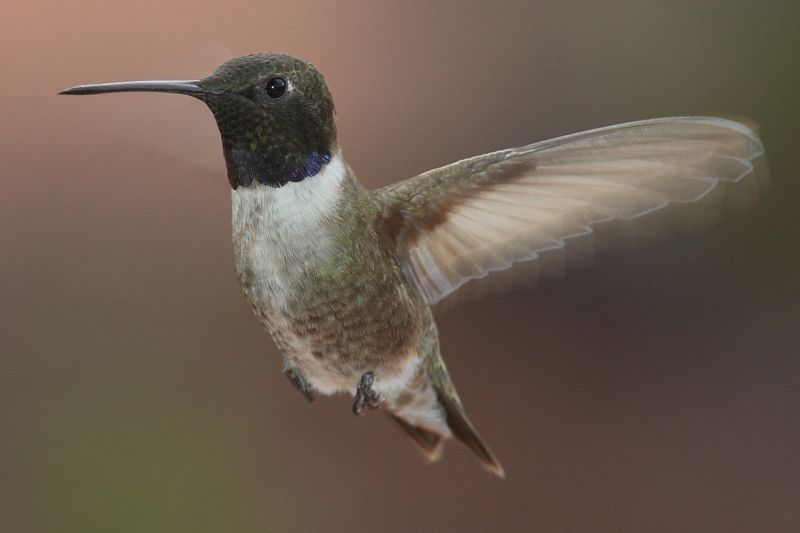
The Black-chinned Hummingbird (Archilochus alexandri) is a small but widely distributed bird. It migrates to Mexico for the winter months, and in summer can be found across much of North America.
The Black-chinned Hummingbird has been known to hybridize with several other species such as Anna’s, Lucifer, Broad-tailed and Costa’s hummingbirds.
It prefers open habitats like desert scrub or grasslands that provide plenty of nectar from flowers.
These birds are also capable flyers, able to reach speeds of up to 34 miles per hour. With its dazzling plumage and impressive flying skills the Black-chinned Hummingbird makes an intriguing sight for any nature enthusiast lucky enough spot one in the wild.Scientific classification:
| Kingdom | Animalia |
| Phylum | Chordata |
| Class | Aves |
| Order | Apodiformes |
| Family | Trochilidae |
| Genus | Archilochus |
| Species | A. alexandri |
Also Featured In: Most Popular Bird Species in North America, Orange County Birds You Need to See
18. Brown-Headed Cowbird
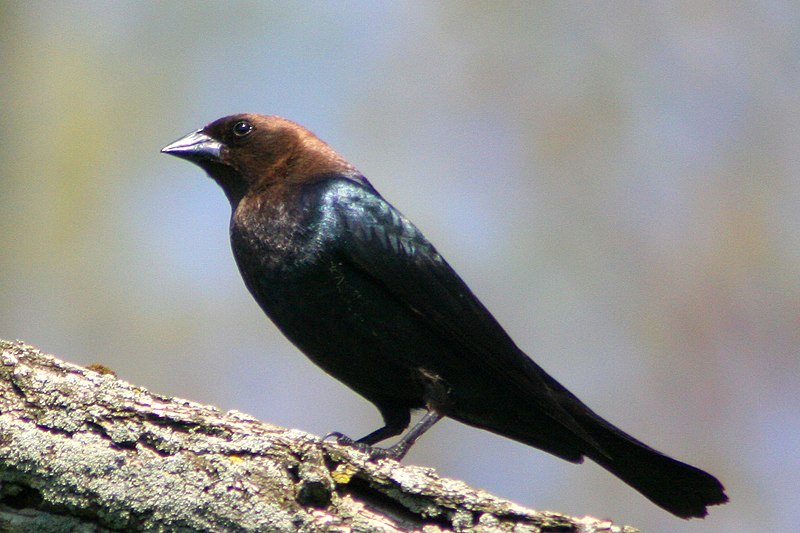
The Brown-headed Cowbird is a small, obligate brood parasitic icterid native to temperate and subtropical North America. It has a brown head with glossy black plumage on the body, wings and tail feathers.
During summer months it can be found in prairies, grasslands as well as open wooded areas but during winter they migrate southwards towards the United States of Mexico for warmer climate.
They are mainly insectivorous birds which feed on insects like caterpillars or beetles but also consume some grains too.
The female bird lays its eggs in nests of other species who then incubates them until hatching time thus leaving their own chicks uncared for by themselves.Scientific classification:
| Kingdom | Animalia |
| Phylum | Chordata |
| Class | Aves |
| Order | Passeriformes |
| Family | Icteridae |
| Genus | Molothrus |
| Species | M. ater |
Also Featured In: Birds You’ll Find in Vancouver Island, Brown Birds that Live in West Virginia
19. Gray Catbird
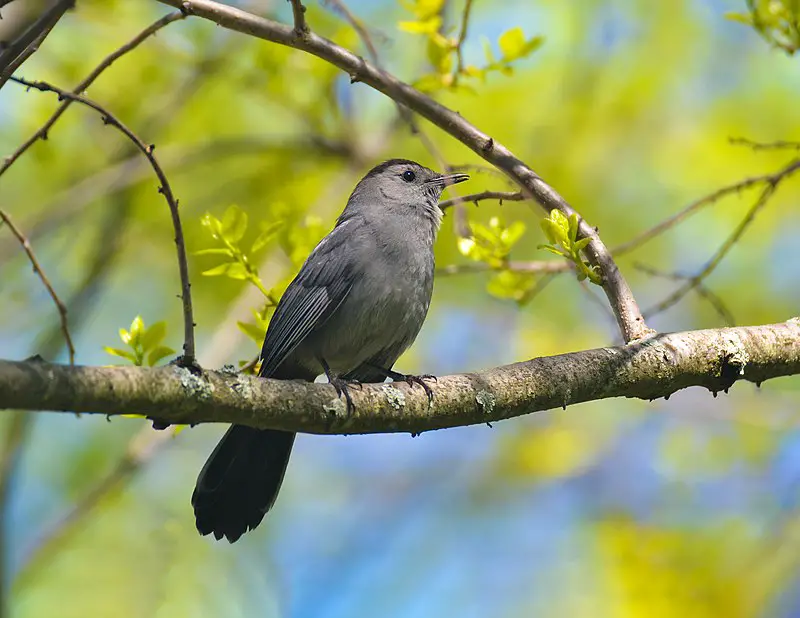
The Gray Catbird is a medium-sized bird native to North and Central America. It is the only species in its genus, Dumetella, which makes it unique among other perching birds of the Mimidae family.
Its plumage features shades of gray with some brownish tones on top and lighter grey below.
The underside of its tail has white feathers that contrast against their otherwise monochromatic coloration; this feature gives them their name as they often flick their tails when alarmed or excited like cats do.
They are omnivorous but mainly feed on insects such as caterpillars, grasshoppers, and beetles while also eating fruits like berries or cherries during summer months.
Despite being commonly seen alone or in pairs these birds will flock together at times for protection from predators like hawks who are drawn to their dark colouration against green foliage making them harder to spot.Scientific classification:
| Kingdom | Animalia |
| Phylum | Chordata |
| Class | Aves |
| Order | Passeriformes |
| Family | Mimidae |
| Genus | Dumetella C.T. Wood, 1837 |
| Species | D. carolinensis |
Also Featured In: Gray Birds that You’ll Find in Minnesota, Birds that Live in Manitoba
20. Yellow-Rumped Warbler

The Yellow-rumped Warbler (Setophaga coronata) is a migratory bird species that can be found throughout North America.
It has an extensive range, from the Pacific and Atlantic coats of the US to Canada and Central America, with a concentration in northern areas during breeding season.
These birds migrate southwards for wintering grounds where they find plentiful food sources such as insects and berries.
They are easily identified by their yellow patches on either side of their tails, along with white underparts, gray back feathers and two distinct crown stripes.
One black or greyish-brown above the eyes extending towards its neck banded in yellow or light brown colouration.
Furthermore, these warblers have strong legs which allow them to cling onto branches while hunting for prey making them adept at maneuvering through tree cover quickly.
All together this makes the Yellow-rumped Warbler an attractive backyard visitor year round.Scientific classification:
| Kingdom | Animalia |
| Phylum | Chordata |
| Class | Aves |
| Order | Passeriformes |
| Family | Parulidae |
| Genus | Setophaga |
| Species | S. coronata |
Also Featured In: Birds that Found in the Yellowstone , Acadia National Park Birds
21. Finches
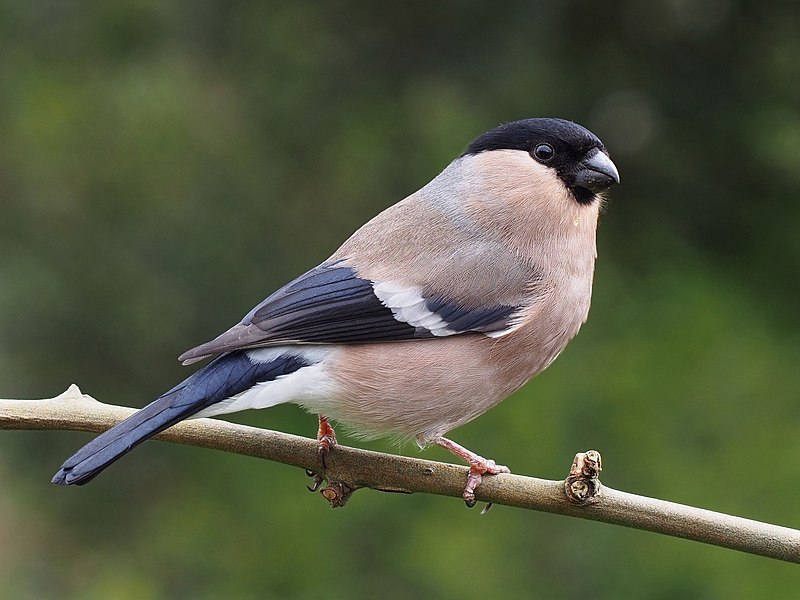
Finches are a diverse group of passerine birds found around the world, excluding Australia and polar regions. They vary in size from small to medium-sized, with stout conical bills adapted for eating seeds and nuts.
Many species have brightly coloured plumage; this helps them stand out against their natural habitats which can range from deserts to forests.
Finches occupy these areas all year round without migrating elsewhere – making them particularly well suited for local environments.
As part of the Fringillidae family they possess unique characteristics that make them popular amongst birdwatchers everywhere.Scientific classification:
| Kingdom | Animalia |
| Phylum | Chordata |
| Class | Aves |
| Order | Passeriformes |
| Superfamily | Passeroidea |
| Family | Fringillidae Leach, 1820 |
Also Featured In: Native Pakistani Birds, Aviary Birds You Should Know
22. White-Winged Dove
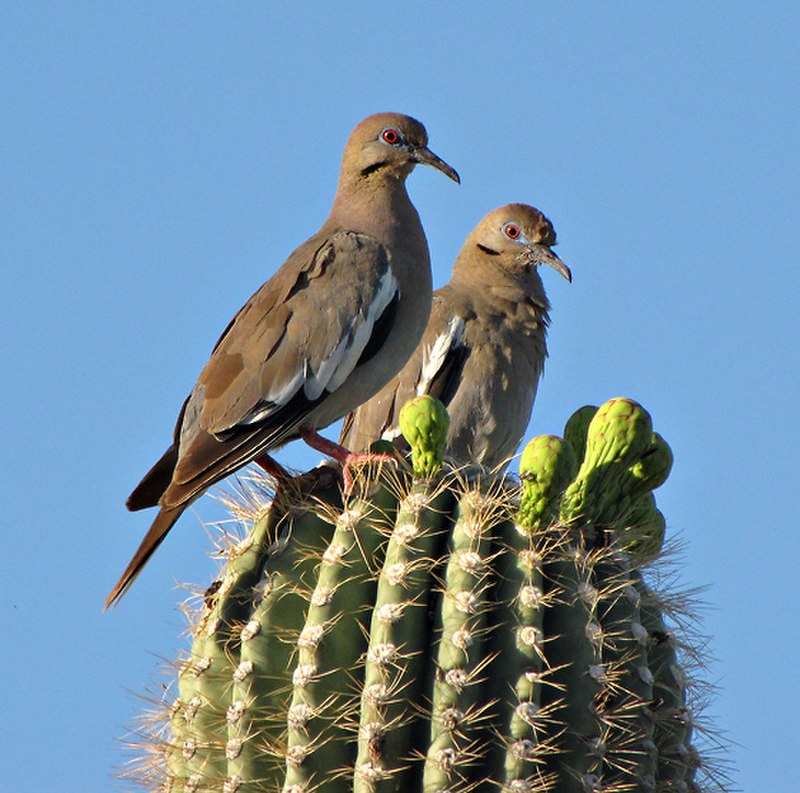
The White-winged Dove is an impressive bird with a large body and wingspan. Its distinctive feature is the white edge on its wings, which makes it easily recognizable when in flight.
It has blue eyerings, red eyes and gray plumage, while juveniles are duller in coloration than adults.
This dove species inhabits areas from Southwestern United States through Mexico to Central America as well as Caribbean islands.
They usually live close to human settlements or cities but can also be found in agricultural fields feeding on grains like corn or wheat seeds left by farmers after harvest season ends.
In their natural habitat they feed primarily on insects, fruits and small plants such as certain cacti species.Scientific classification:
| Kingdom | Animalia |
| Phylum | Chordata |
| Class | Aves |
| Order | Columbiformes |
| Family | Columbidae |
| Genus | Zenaida |
| Species | Z. asiatica |
Also Featured In: Top Birds Found in Mexico, Birds You’ll Find in the Rio Grande Valley
23. Lesser Goldfinch
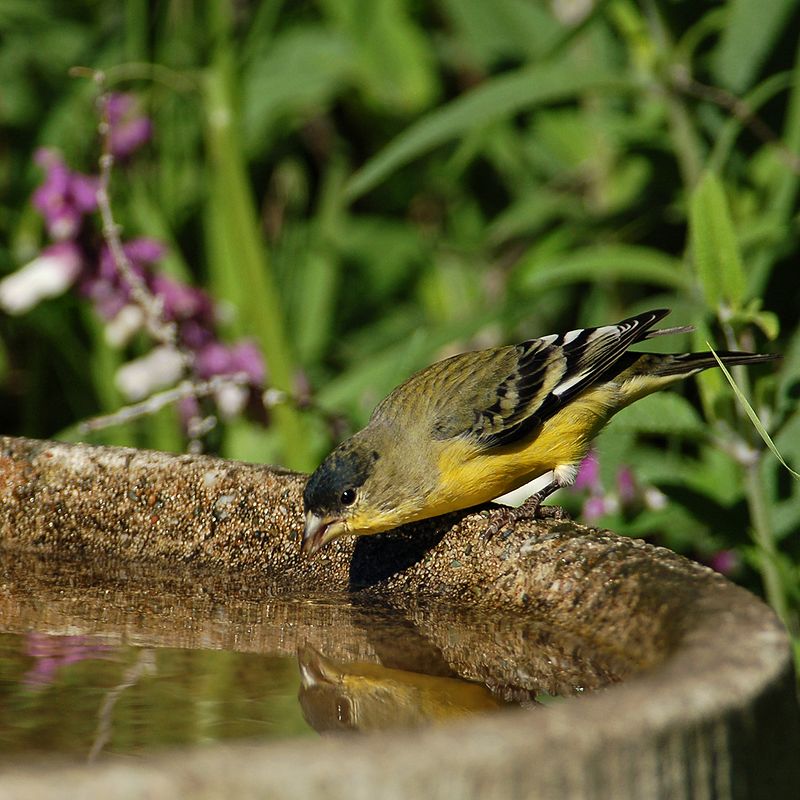
The Lesser Goldfinch is a tiny species of bird found in the Americas. It belongs to the same clade as American goldfinches and Lawrence’s goldfinches, which can be identified by their males having black or rarely green foreheads.
The face appears red or yellow on these birds unlike other species in its genus Spinus sensu stricto.
They are small songbirds with short bills, brown wings and tails with white edges, grey-brown backs and olive heads.
These birds inhabit open woodlands and fields where they feed mainly on seeds from weeds such as thistle, pigweed and ragweed but also consume insects at times during breeding season for additional nutrition.
In addition to being an important part of North America’s avian ecology, these birds have been popularized through recent artwork depicting them in various poses among flowers.Scientific classification:
| Kingdom | Animalia |
| Phylum | Chordata |
| Class | Aves |
| Order | Passeriformes |
| Family | Fringillidae |
| Subfamily | Carduelinae |
| Genus | Spinus |
| Species | S. psaltria |
Also Featured In: Birds that Live in Yosemite National Park, Common Yellow Birds of Idaho
24. Cardinal
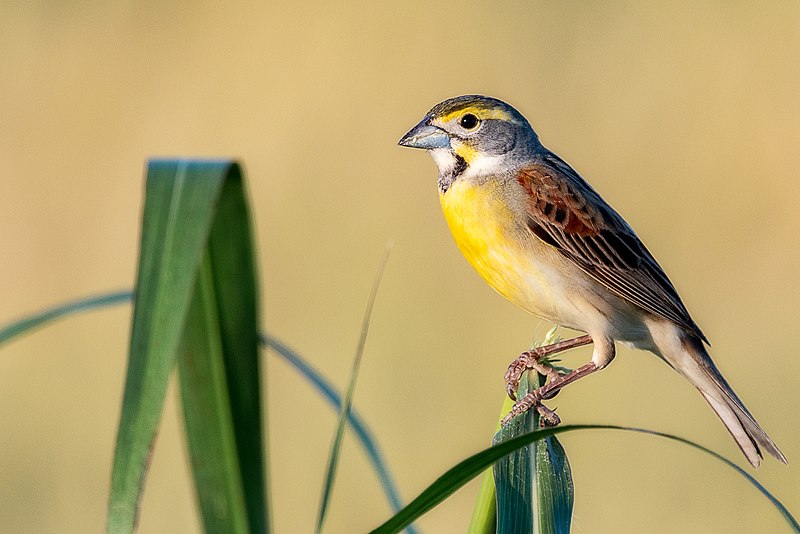
Cardinalidae is a family of passerine birds endemic to the New World that includes cardinals, grosbeaks and buntings.
This large group has great diversity in its members which range from tanager-like Piranga to warbler-like Granatellus.
They are usually distinguished by their bright plumage with reds, oranges and yellows being common among them.
Their strong bills enable them to feed on seeds, fruits and insects as well as other small prey items like lizards or frogs depending upon species.
Cardinals also have loud calls often used for territorial defense and courtship purposes while some can even imitate sounds made by other animals.
These adaptable birds inhabit a variety of habitats across North America making them an important part of many ecosystems there.Scientific classification:
| Kingdom | Animalia |
| Phylum | Chordata |
| Class | Aves |
| Order | Passeriformes |
| Superfamily | Emberizoidea |
| Family | Cardinalidae Ridgway, 1901 |
Also Featured In: Common Birds in Canada, Flight Birds You Should Know
25. Buff-Bellied Hummingbird
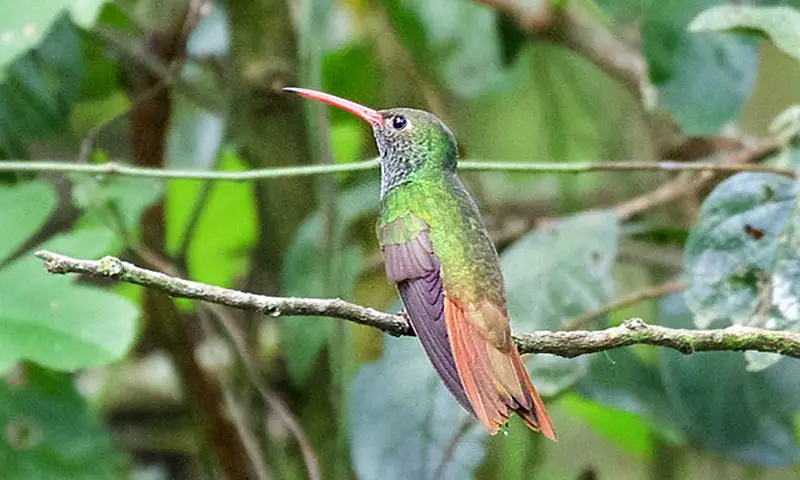
The Buff-bellied Hummingbird is a species of hummingbird belonging to the Trochilini tribe and found in Central America and parts of the United States.
It has three subspecies: A. y. yucatanensis, A. y chalconota, and A.y cerviniventris whose length ranges from 3.9 – 4 inches (10 – 11 cm).
The buff-bellied hummingbird’s plumage is mainly grey with greenish reflections on its back while it sports a distinctive buff colored belly which gives this species its name.
Its diet consists mostly of nectar as well as small insects; they often feed upon flowers near rivers or other bodies of water where their preferred food sources are plentiful.
In addition to being quite beautiful birds, these delightful creatures also possess an impressive ability for hovering flight making them one of nature’s most graceful avian wonders.Scientific classification:
| Kingdom | Animalia |
| Phylum | Chordata |
| Class | Aves |
| Order | Apodiformes |
| Family | Trochilidae |
| Genus | Amazilia |
| Species | A. yucatanensis |
Also Featured In: Most Beautiful Birds in Guatemala, Red Birds You’ll Commonly Found in Texas
26. Yellow-Throated Warbler
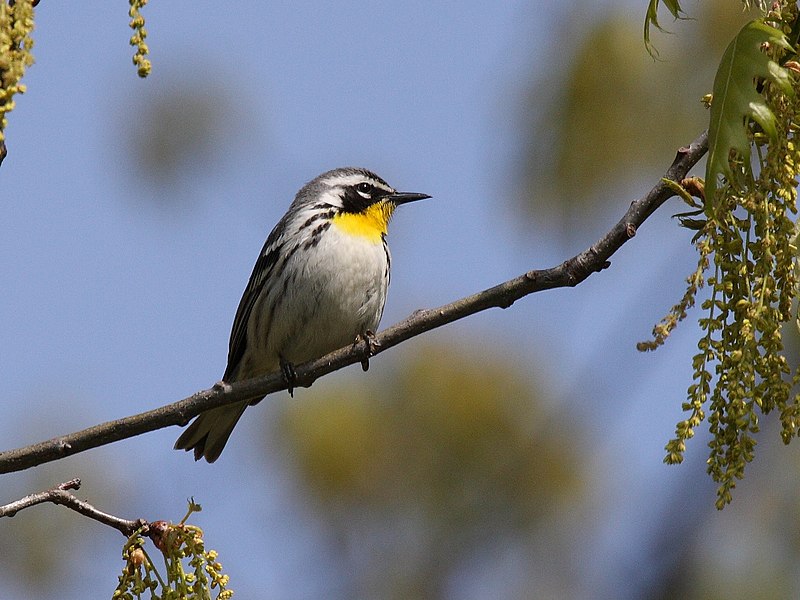
The Yellow-throated Warbler (Setophaga dominica) is a small migratory songbird found in temperate North America. It belongs to the Parulidae family of New World warblers.
Males have grey upperparts and wings with double white wing bars, yellow throats, and white underparts streaked with black on the flanks.
Females are less brightly colored, having olive green or brownish gray back and wings with two faint wingbars instead of one bright one visible in males.
These birds feed mainly on insects during their breeding season but will also eat fruits at other times of year while they migrate southwards for wintering grounds where they will search for nectar from flowers as well as fruit sources such as berries and wild grapes.
They can be seen actively searching through trees for food items near bird feeders during migration time periods making them an interesting species to observe.Scientific classification:
| Kingdom | Animalia |
| Phylum | Chordata |
| Class | Aves |
| Order | Passeriformes |
| Family | Parulidae |
| Genus | Setophaga |
| Species | S. dominica |
Also Featured In: Birds of Haiti, Yellow Georgia Birds
27. Red-Tailed Hawk
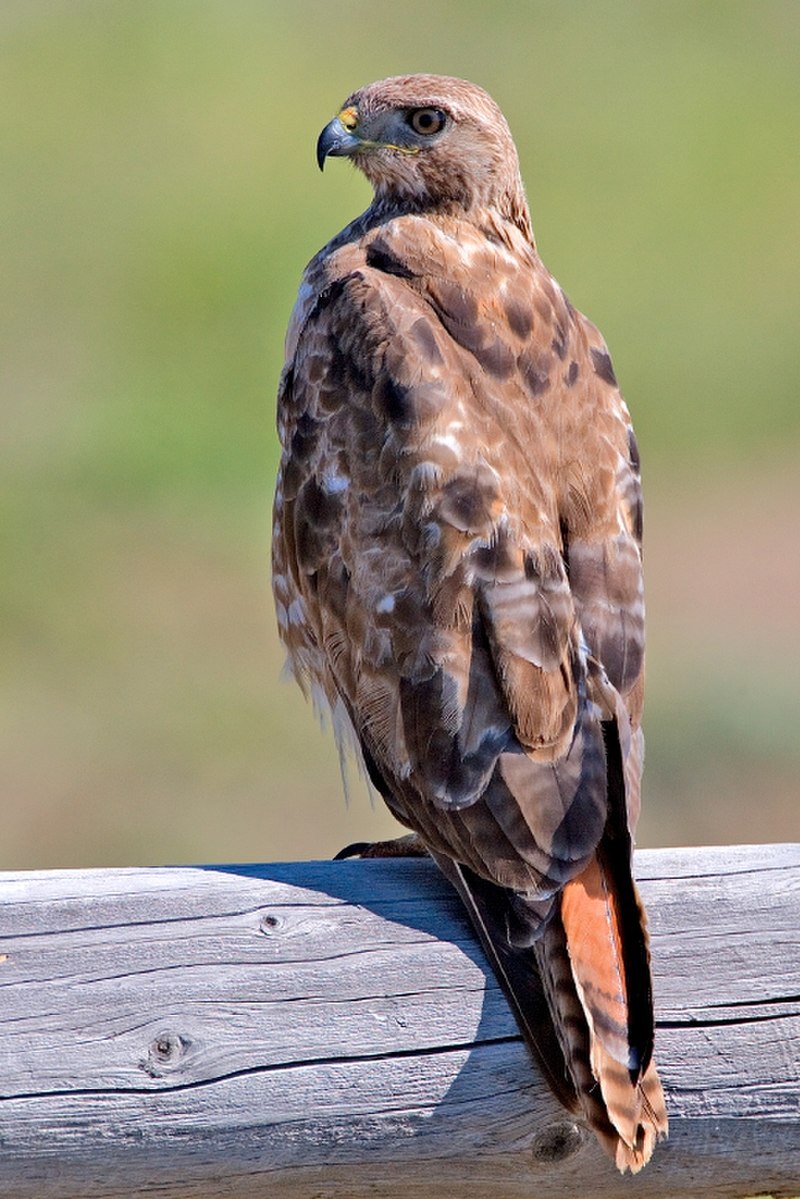
The Red-tailed Hawk is a majestic bird of prey with its distinctive red tail. It can be found throughout North America, from Alaska in the north to Panama and the West Indies in the south.
This species belongs to Buteo genus, which makes it one of most common raptors on earth.
These hawks mainly hunt small mammals such as rabbits or squirrels but also feed on reptiles and birds during migration season.
Unlike other predator birds, they prefer open areas for hunting like fields or grasslands rather than dense forests.
They build their nests high up on trees where they stay all year long unless disturbed by humans or animals nearby.
Their presence has become an iconic part of American culture due to their frequent sightings around homes and parks alike making them beloved creatures among people everywhere.Scientific classification:
| Kingdom | Animalia |
| Phylum | Chordata |
| Class | Aves |
| Order | Accipitriformes |
| Family | Accipitridae |
| Genus | Buteo |
| Species | B. jamaicensis |
Also Featured In: Dominican Republic birds, Birds You’ll Find in Zoo
28. Black-Bellied Whistling Duck
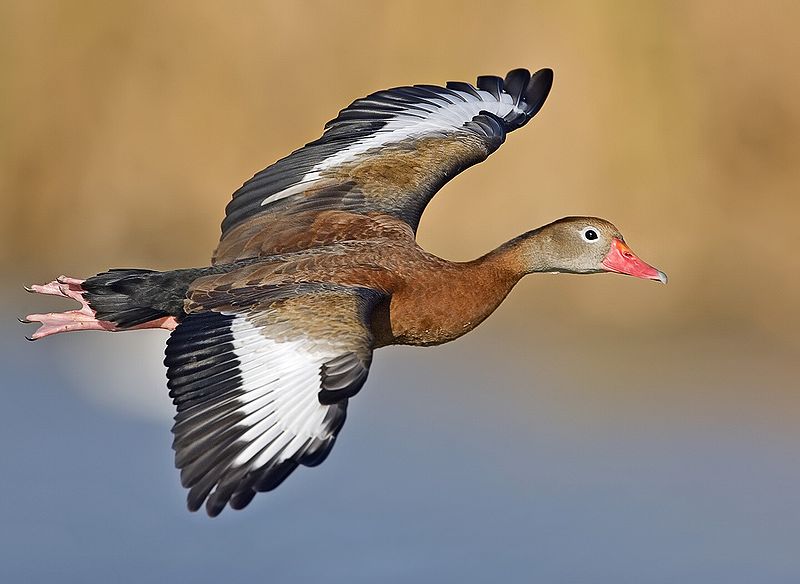
The Black-bellied whistling duck is a unique species of bird that can be found in the southern United States, Mexico, Central and South America. This small waterfowl has distinct black plumage on its belly which gives it its name.
Its call is also distinctive as it makes high pitched whistles to communicate with other members of its flock.
It prefers wetland habitats such as marshes, ponds and lakes where they feed on seeds and aquatic plants like wild rice or pondweed.
During breeding season these birds form monogamous pairs nesting in trees near bodies of water.
They are migratory birds but some may remain year round depending upon local climate conditions making them relatively common sights in certain areas during winter months when most other ducks have migrated further south for warmer weather.Scientific classification:
| Kingdom | Animalia |
| Phylum | Chordata |
| Class | Aves |
| Order | Anseriformes |
| Family | Anatidae |
| Genus | Dendrocygna |
| Species | D. autumnalis |
Also Featured In: El Salvador Birds, Common San Antonio Birds
29. Carolina Chickadee
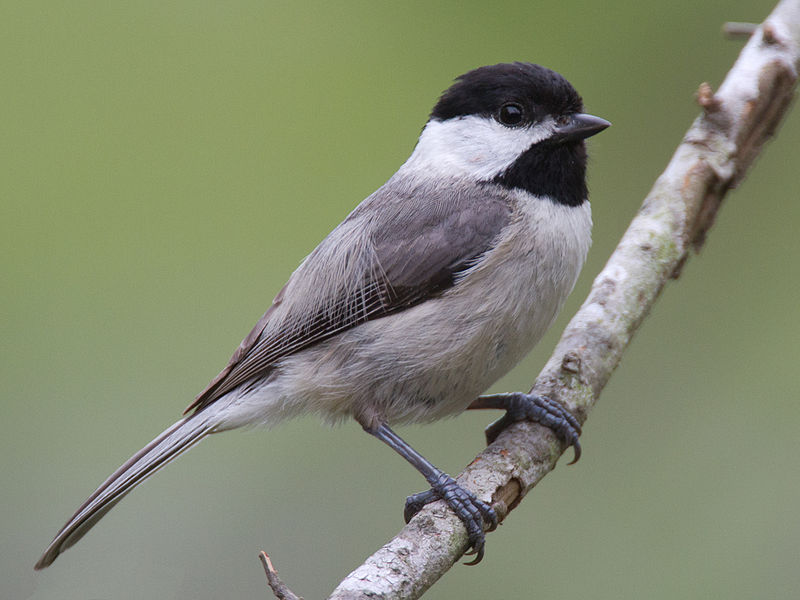
The Carolina Chickadee is a small passerine bird found in the tit family Paridae. It stands out for its distinct black and white, grey-brown feathers with an offwhite underside.
This species can be spotted by its call: “chick-a-dee”. The American Ornithologists’ Union has classified them into their own genus called Poecile as they differ from other tits due to both genetic data and morphology.
These birds are found all over North America, living in wooded areas near open fields or water sources.
They feed on insects such as caterpillars but also have been known to eat suet at backyard feeders during winter months when food is scarce.Scientific classification:
| Kingdom | Animalia |
| Phylum | Chordata |
| Class | Aves |
| Order | Passeriformes |
| Family | Paridae |
| Genus | Poecile |
| Species | P. carolinensis |
Also Featured In: Georgia Birds, Small Birds that Live in Washington D.C.
30. Brown-Headed Nuthatch
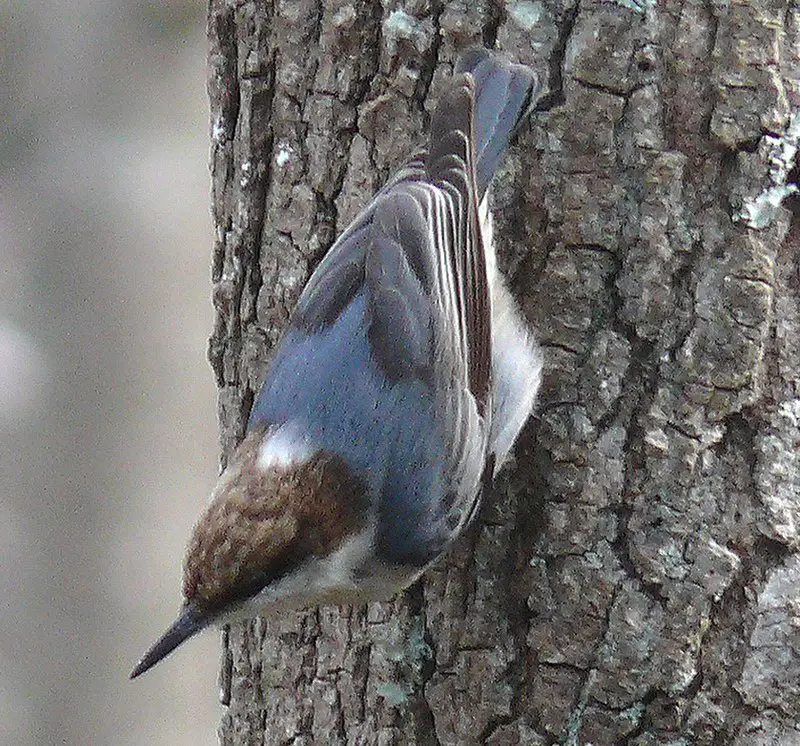
The brown-headed nuthatch is a small songbird native to pine forests in the southeastern US. With its brown head and blue-gray body, it’s easily recognizable.
Recent genetic analyses have revealed low differentiation between northern and southern populations in Florida, yet unfortunately lower genetic diversity among south Florida populations due to habitat fragmentation.
The Bahamas represent an isolated population of this species that may be at risk from human activity or other forms of disturbance such as hurricanes.
Conservation efforts will help ensure the protection of these birds for generations to come.Scientific classification:
| Kingdom | Animalia |
| Phylum | Chordata |
| Class | Aves |
| Order | Passeriformes |
| Family | Sittidae |
| Genus | Sitta |
| Species | S. pusilla |
Also Featured In: Brown Tennessee Birds, Red Birds of North Carolina
31. Ruby-Throated Hummingbird

The ruby-throated hummingbird (Archilochus colubris) is a species of hummingbird that has an impressive migration pattern, spending the winter in Central America, Mexico and Florida before flying to Canada and other parts of Eastern North America for breeding season.
It’s by far the most common type seen east of the Mississippi River in North America.
Formally described by Swedish naturalist Carl Linnaeus in 1758, this tiny bird has bright metallic green upperparts with white underparts, a small black bill and a red throat patch which gives it its name; they measure around 3 inches long on average.
They feed primarily on nectar from flowers but also eat insects such as flies or mosquitoes for extra protein during their migrations or when raising young chicks.Scientific classification:
| Kingdom | Animalia |
| Phylum | Chordata |
| Class | Aves |
| Order | Apodiformes |
| Family | Trochilidae |
| Genus | Archilochus |
| Species | A. colubris |
Also Featured In: Red Birds You’ll See in Oklahoma, Red Minnesota Birds You Need to Know
32. Ruby-Crowned Kinglet
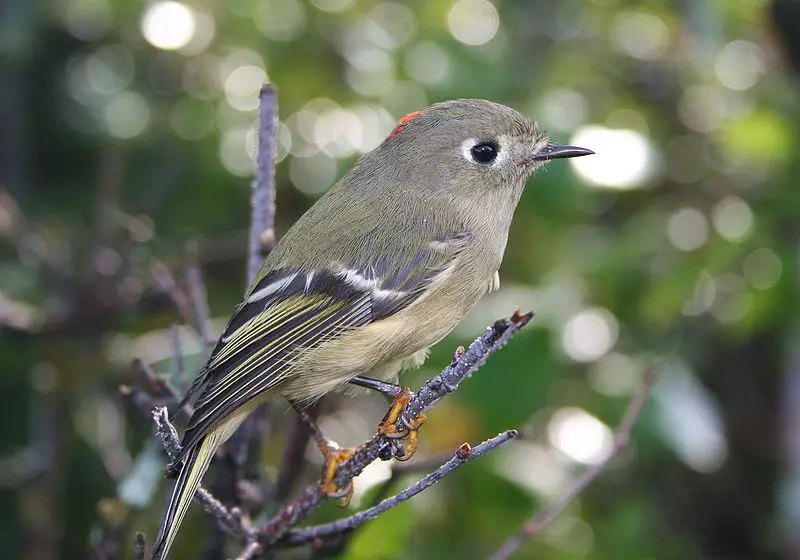
The Ruby-crowned Kinglet is a small passerine bird native to North America. It has olive green plumage, white wing bars and an eye-ring as well as a distinctive red crown patch on the males.
Juveniles look similar to adults with no distinguishing features other than size.
They are usually found in coniferous forests or woodlands where they spend much of their time searching for insects among foliage and branches while constantly flitting from place to place.
These birds have incredible energy levels that allow them to travel long distances during migration season without getting exhausted too quickly, making them one of nature’s most resilient species.Scientific classification:
| Kingdom | Animalia |
| Phylum | Chordata |
| Class | Aves |
| Order | Passeriformes |
| Family | Regulidae |
| Genus | Corthylio Cabanis, 1853 |
| Species | C. calendula |
Also Featured In: Native Birds in Lower Rio Grande Valley, Green Birds Commonly Found in Florida
33. Eastern Phoebe
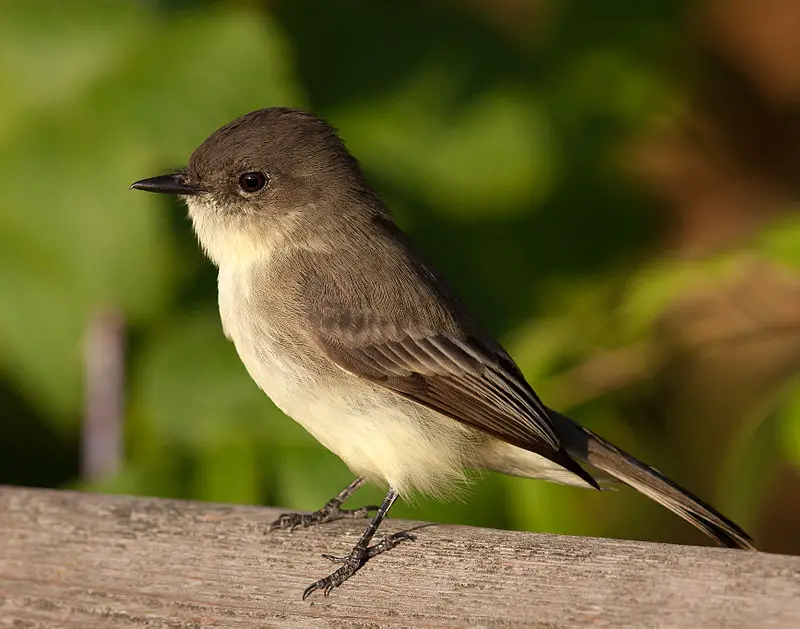
The Eastern Phoebe is a small passerine bird belonging to the genus Sayornis. It gets its name from Charles Lucien Bonaparte’s Muscicapa saya, and Ancient Greek ornis meaning “bird”.
The species’ alternative name ‘Phoebe’ comes from the Roman moon-goddess Diana, but also has been said to imitate their call.
Measuring up to 16 cm in length with a wingspan of 25–30 cm, they have grayish brown upperparts and pale underparts.
They are found near streams, woodlands and open fields where they hunt for insects such as flies, bees wasps etc., often catching them midair or by sallying out from perchs like branches or fences.
These birds make shallow cup nests made of grasses lined with mud which are built on cliffs ledges walls buildings bridges trees etc..
All in all this beautiful little bird is an interesting addition wherever you find it.Scientific classification:
| Kingdom | Animalia |
| Phylum | Chordata |
| Class | Aves |
| Order | Passeriformes |
| Family | Tyrannidae |
| Genus | Sayornis |
| Species | S. phoebe |
Also Featured In: Birds that Make Mud Nests, Brown Birds that are Found in Mississippi
34. Eastern Screech Owl
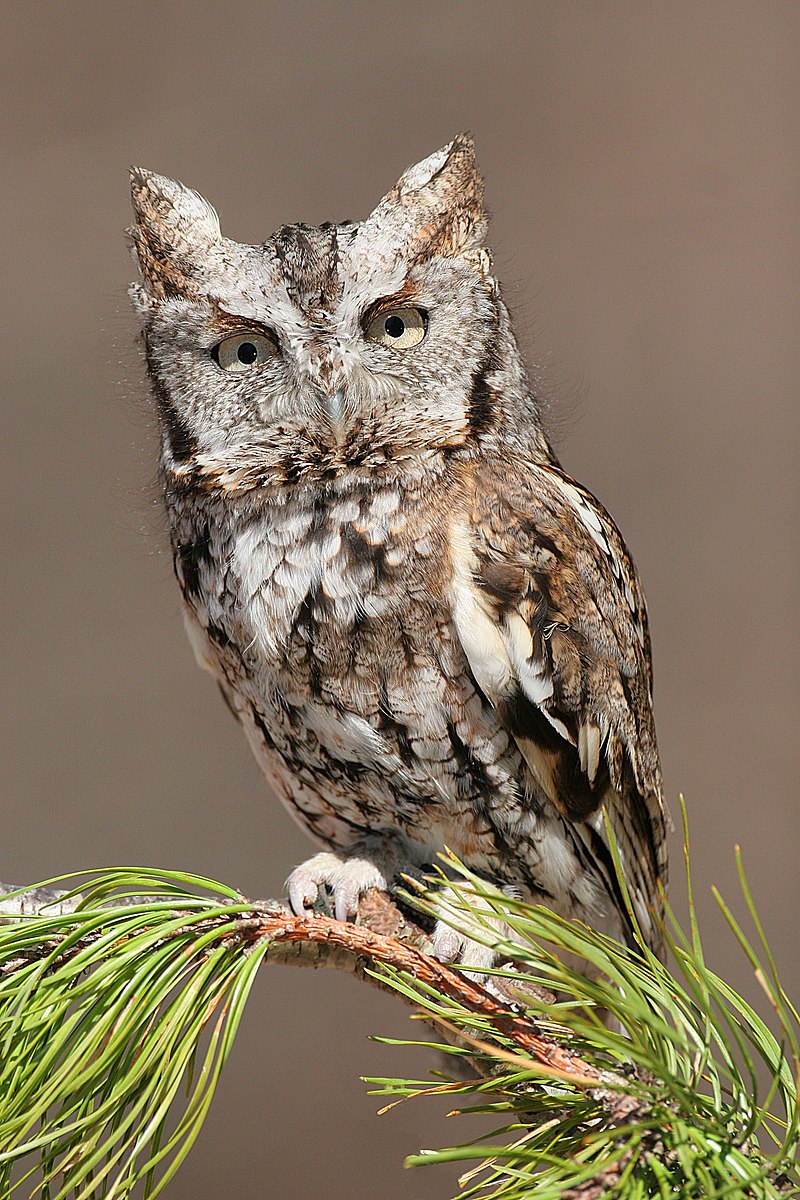
The Eastern screech owl is a small nocturnal bird native to most wooded areas in Mexico and Canada. It has adapted well to human development, making it relatively common in East North America.
This species is known for its unique call which often sounds like a horse whinnying or an electronic beep.
Its feathers are mainly grey with brown bars, but they can also range from red-brown to blackish-grey depending on the individual bird’s location.
They feed primarily on insects and other small animals such as mice and lizards that live near their nest sites at night.
The eastern screech owl is an amazing creature adapting well to humans while still managing to stay hidden under cover of darkness.Scientific classification:
| Kingdom | Animalia |
| Phylum | Chordata |
| Class | Aves |
| Order | Strigiformes |
| Family | Strigidae |
| Genus | Megascops |
| Species | M. asio |
Also Featured In: Birds You’ll Find in Night, Common Vermont Winter Birds
35. House Wren
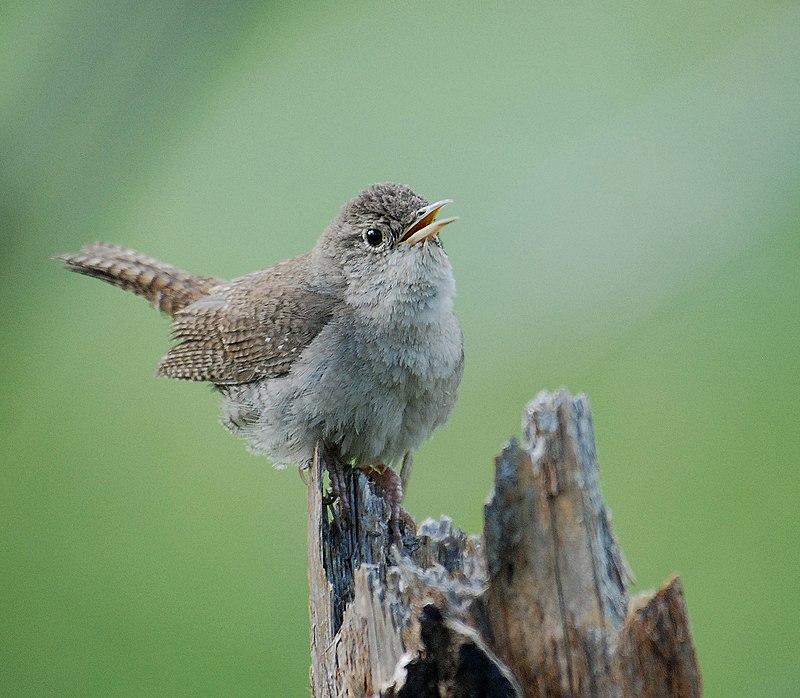
The House Wren is a small bird of the wren family found from Canada to South America. It’s quite common in suburban areas and is one of the most widely distributed native birds in North and South America.
Its taxonomy can be complicated, with some subspecies groups considered separate species.
The House Wren has a brown back, grey head, white eyebrow stripes, light chestnut belly and buffy flanks.
They often inhabit old or abandoned buildings as well as shrublands near fields or open woods for nesting sites.
During breeding season they are highly territorial so make sure you create an inviting environment if you wish to invite them into your yard.Scientific classification:
| Kingdom | Animalia |
| Phylum | Chordata |
| Class | Aves |
| Order | Passeriformes |
| Family | Troglodytidae |
| Genus | Troglodytes |
| Species | T. aedon |
Also Featured In: Suriname birds, Small Birds Live in Vermont
36. White-Eyed Vireo
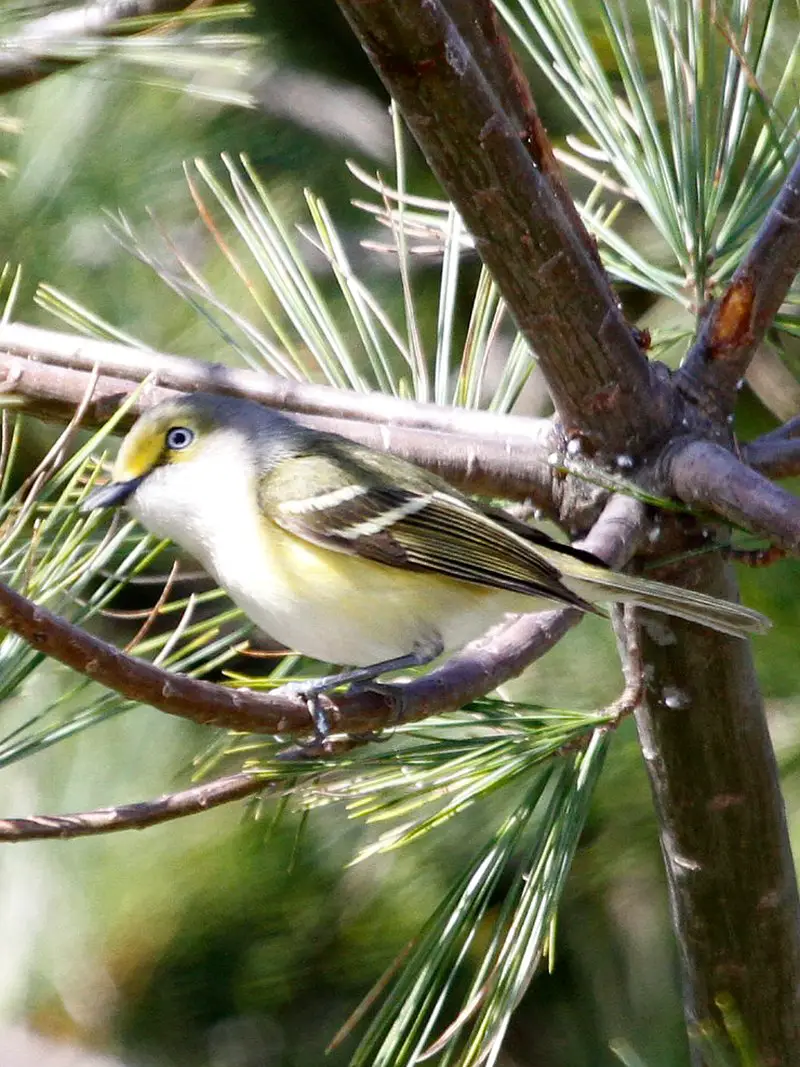
The White-eyed vireo is a small songbird in the family Vireonidae, native to parts of eastern United States from New England to northern Missouri, Texas and Florida.
It also occurs in Mexico, Central America, Cuba and Caribbean islands such as Bahamas.
These birds are migratory on their North American range but become resident further south towards Gulf Coast.
They inhabit wooded areas with thick shrubbery or foliage which offer plenty of insects for them to feed upon.
Their call consists of sharp ‘chick’ notes while they sing a sweet melodious warble during breeding season making them popular among birdwatchers all over the world.Scientific classification:
| Kingdom | Animalia |
| Phylum | Chordata |
| Class | Aves |
| Order | Passeriformes |
| Family | Vireonidae |
| Genus | Vireo |
| Species | V. griseus |
Also Featured In: Bermuda birds, Yellow Birds You’ll Find in North Carolina
37. Black-Crested Titmouse
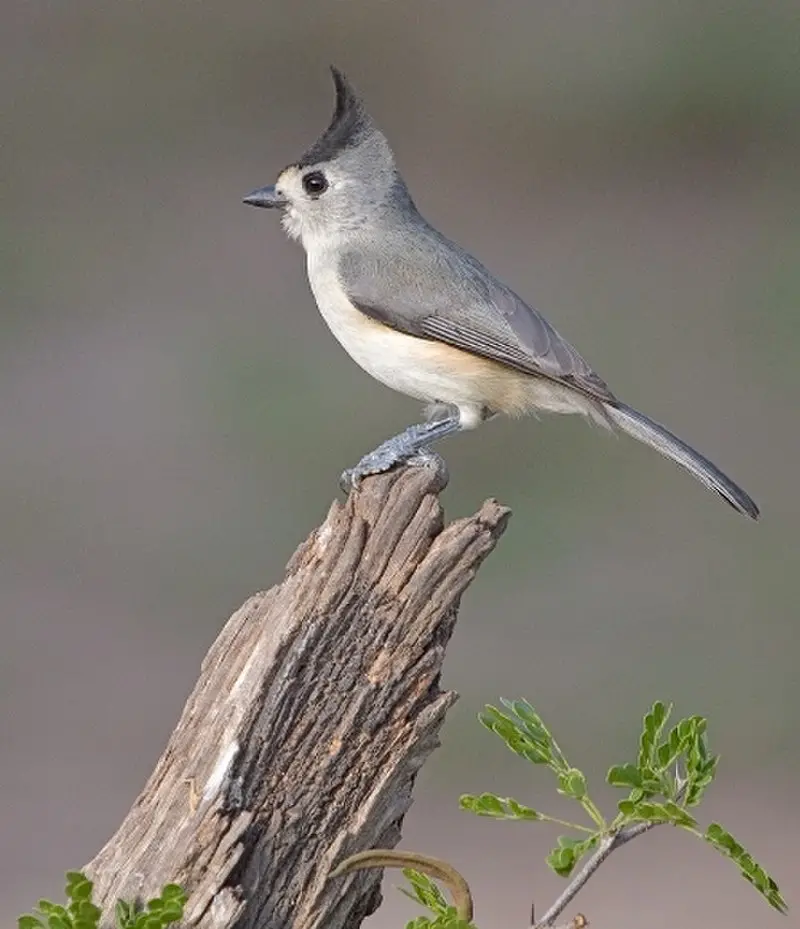
The Black-crested titmouse is a passerine bird in the Paridae family and was recently recognised as its own species.
Native to southern Texas, Oklahoma and east central Mexico, they have been known to make their way as far north and east as St. Louis Missouri through vagrancy.
The birds measure between 5 – 6 inches long with an overall grey colouring featuring white underparts and black crowns on their heads giving them the name ‘Black-crested’.
These birds are omnivores foraging for insects, fruit or seeds depending on seasonality of food sources available at different times throughout the year.
They form monogamous pairs typically making nests of twigs lined with grasses & feathers which both parents take part in building & raising young before fledging.Scientific classification:
| Kingdom | Animalia |
| Phylum | Chordata |
| Class | Aves |
| Order | Passeriformes |
| Family | Paridae |
| Genus | Baeolophus |
| Species | B. atricristatus |
Also Featured In: Chickadees Birds, Central Texas Birds
38. American Bushtit
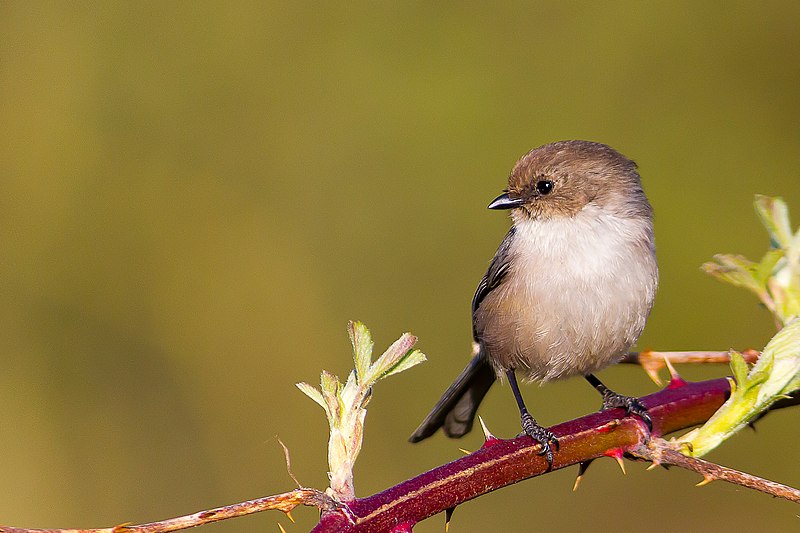
The American bushtit is a small, social bird found in the New World. It’s the only species of its genus and family, Psaltriparus minimus.
First described by John Kirk Townsend in 1837, it inhabits forests and coasts from Alaska to Mexico.
With their tiny size (4-5 inches) they are easily identified by their gray or brown backs with white underparts.
Bushtits have long wings allowing them to travel quickly between trees; they form flocks that move together through branches looking for food such as insects, spiders eggs and fruit while emitting soft chirps or squeaks.
They build beautiful large pendulous nests made of mosses which hang from tree branches high above ground level where they sleep at night.
These charming birds make delightful company during outdoor activities like hiking or camping trips.Scientific classification:
| Kingdom | Animalia |
| Phylum | Chordata |
| Class | Aves |
| Order | Passeriformes |
| Family | Aegithalidae |
| Genus | Psaltriparus Bonaparte, 1850 |
| Species | P. minimus |
Also Featured In: Birds That Live in Colorado, Birds Live Near San Diego
39. Blue-Gray Gnatcatcher
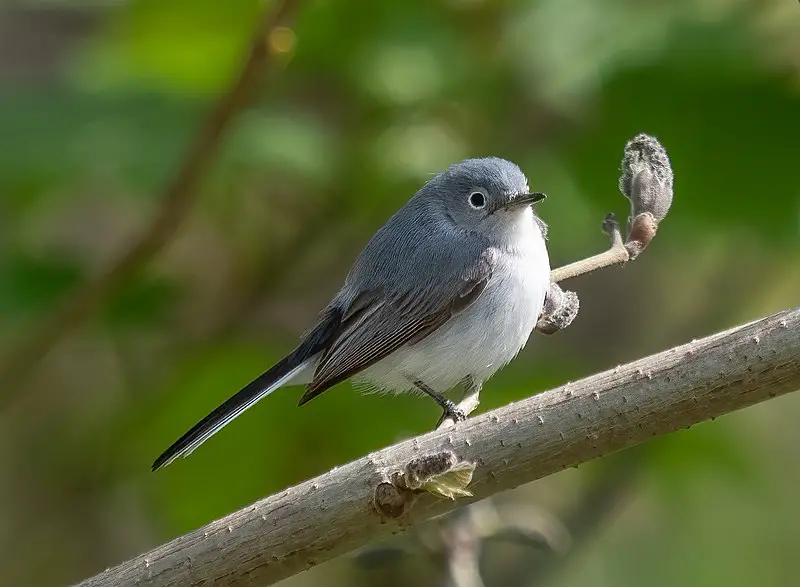
The Blue-gray Gnatcatcher is a beautiful small songbird native to North America. It has a length of 10–13 cm (3.9–5.1 in), wingspan of 6.3 in (16 cm) and weighs only 5–7 g (0.18–0.25 oz).
Males have blue-gray upperparts with white underparts, slender dark bill, and long black tail edged in white; females are less vibrant but still eye catching.
Juveniles are brownish gray overall but may show some hints of the adult colouration around their tails or shoulders as they mature into adulthood.
Their diet consists mainly of insects which they catch while flitting through air like tiny darts.
This stunning species can be found anywhere from woodlands to urban parks so keep your eyes peeled for these delightful creatures on your next outdoor adventure.Scientific classification:
| Kingdom | Animalia |
| Phylum | Chordata |
| Class | Aves |
| Order | Passeriformes |
| Family | Polioptilidae |
| Genus | Polioptila |
| Species | P. caerulea |
Also Featured In: Blue Birds You’ll Found around Us, Birds that Live around Central Florida
40. Scissor-Tailed Flycatcher
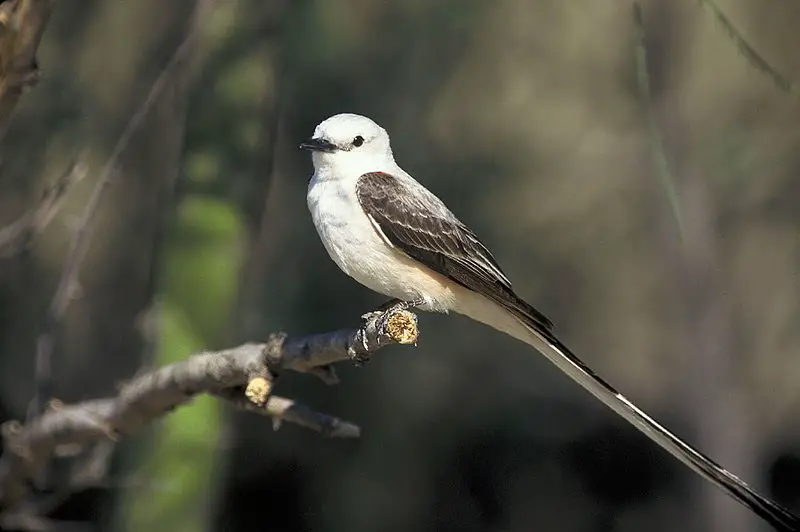
The scissor-tailed flycatcher is a beautiful bird, belonging to the Tyrannus genus of kingbirds. It is known by various names such as Texas Bird-of Paradise and Swallow-tailed Flycatcher.
This insectivorous bird has an impressive long tail which it uses for courtship displays and aerial acrobatics – making it quite the showstopper.
Its range includes North America and Central South American regions where they breed in open fields, pastures or grasslands with scattered trees available.
They feed on insects like dragonflies, damselflies and small moths that they catch while gliding through air gracefully with their wings spread apart wide.
To watch this amazing creature soar freely over its habitat would be nothing short of breathtaking.Scientific classification:
| Kingdom | Animalia |
| Phylum | Chordata |
| Class | Aves |
| Order | Passeriformes |
| Family | Tyrannidae |
| Genus | Tyrannus |
| Species | T. forficatus |
Also Featured In: Flycatchers Species, Birds You’ll Find in South Texas
41. Rufous Hummingbird
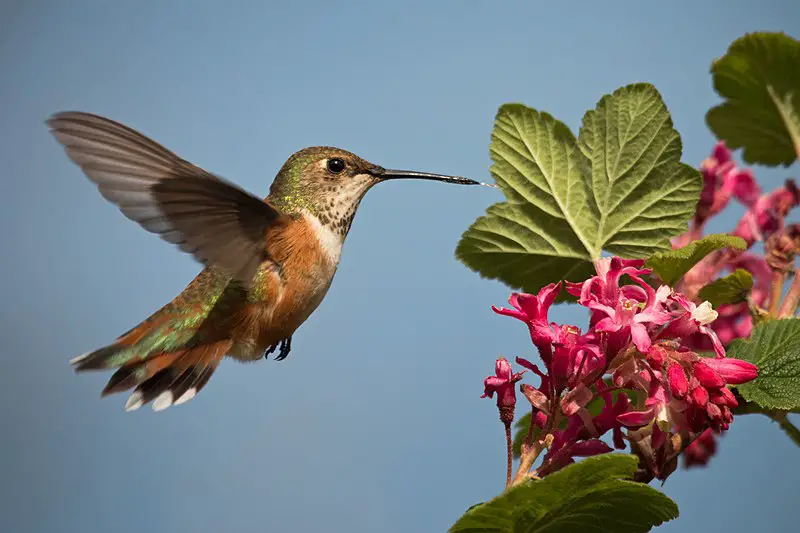
The beautiful Rufous Hummingbird is a small bird of 8 cm in length, with a long slender beak. It stands out due to its extraordinary flight skills and incredible migratory transits- they can fly up to 2,000 miles.
This species was formally described by German naturalist Johann Friedric in 1788 and belongs to the genus Selasphorus.
These birds are found all over North America and parts of Mexico during summertime; while wintering in Central America or northern South America.
They feed on nectar from flowers as well as insects for protein intake. With their vibrant feathers, agile flying abilities and fascinating life cycle they make an interesting addition to any backyard wildlife habitat.Scientific classification:
| Kingdom | Animalia |
| Phylum | Chordata |
| Class | Aves |
| Order | Apodiformes |
| Family | Trochilidae |
| Genus | Selasphorus |
| Species | S. rufus |
Also Featured In: Hummingbirds Species, British Columbian Birds
42. Violet-Green Swallow
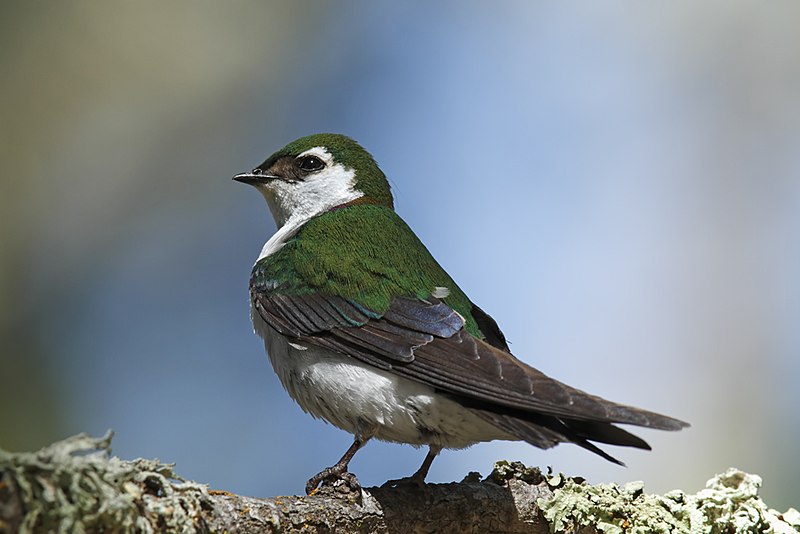
The Violet-green Swallow is a small, North American passerine bird belonging to the swallow family.
These birds are known for their aerial insectivorous diet and beautiful green coloration with white rump side patches that appear as if they’re separating it from other swallows.
They inhabit areas along the west coast of America, ranging from Alaska all the way down to Mexico and also extending eastwards to Montana and Texas.
This species can be seen swooping through open air in search of food or heard chirping away during its mating season – usually occurring between April till late summer months.
It’s an important part of many ecosystems due to its role in controlling insects populations.Scientific classification:
| Kingdom | Animalia |
| Phylum | Chordata |
| Class | Aves |
| Order | Passeriformes |
| Family | Hirundinidae |
| Genus | Tachycineta |
| Species | T. thalassina |
Also Featured In: Swallows Species, House Birds You’ll Love to Pet
43. White-Tailed Kite
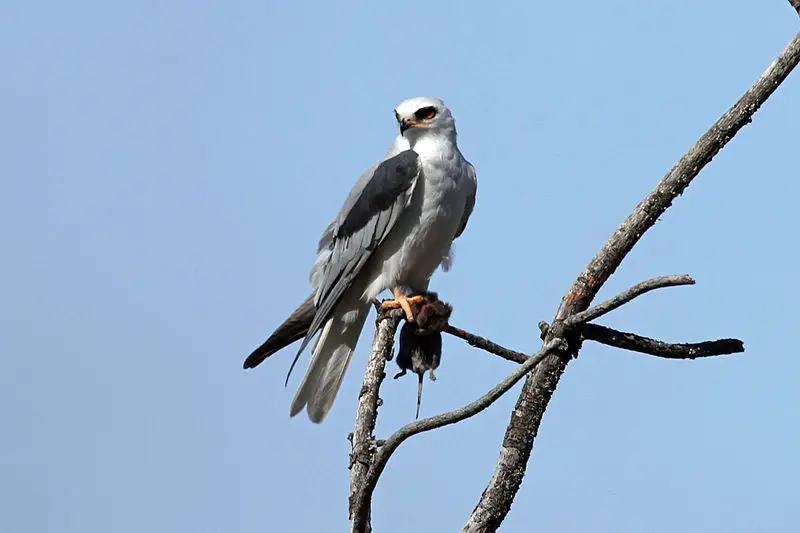
The White-tailed Kite is a small raptor found in western North America and parts of South America. It was first described by French ornithologist Louis Jean Pierre Vieillot in 1818, with the type locality being Paraguay.
This species belongs to the same family as Old World black-winged kites, but is more widespread than its relative.
They are recognized easily due to their distinct white heads and tails, grey wings and backs, yellow eyes and legs.
Theses birds primarily hunt for rodents such as mice during daylight hours using their exceptional hunting skills like hovering midair before diving down on prey or swooping low over grasslands looking for food items on the ground.
In addition they also feed upon insects including grasshoppers and locusts which provides them additional nutrition throughout summer months.Scientific classification:
| Kingdom | Animalia |
| Phylum | Chordata |
| Class | Aves |
| Order | Accipitriformes |
| Family | Accipitridae |
| Genus | Elanus |
| Species | E. leucurus |
Also Featured In: Common Californian Birds, Common Southern Californian Birds
44. Painted Bunting
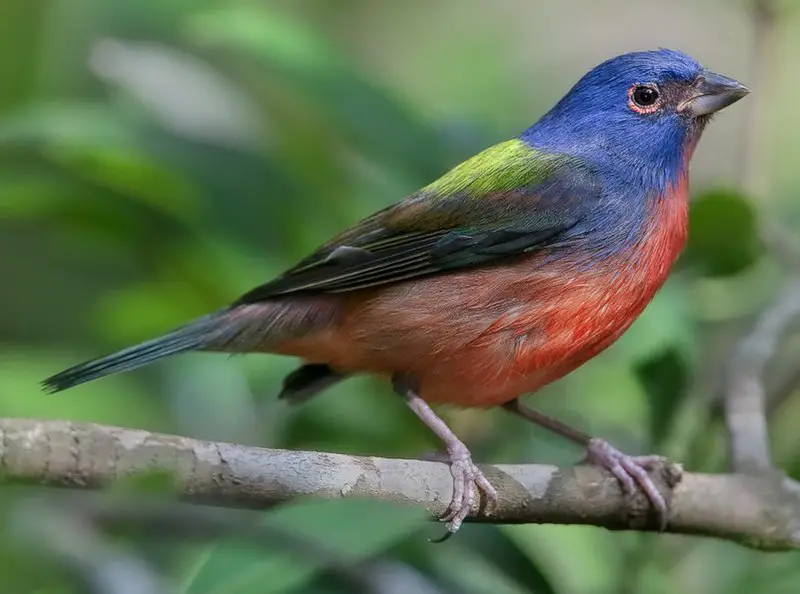
The Painted Bunting is an eye-catching bird from the Cardinal family, native to North America. It was first described by Carl Linnaeus in his eighteenth-century Systema Naturae.
The males of this species are particularly striking; they have brightly coloured plumage which only appears after their second year of life and can be distinguished from female birds through close inspection.
These colourful songbirds are a delight for any avid birder, with their vibrant hues bringing joy to nature lovers everywhere.
They often inhabit woodland areas where there is plenty of seed and insects available for them to feed on – as well as some shrubbery so that they can hide away safely when needed.Scientific classification:
| Kingdom | Animalia |
| Phylum | Chordata |
| Class | Aves |
| Order | Passeriformes |
| Family | Cardinalidae |
| Genus | Passerina |
| Species | P. ciris |
Also Featured In: Texas Birds, Flocks Birds around Us
45. Orange-Crowned Warbler
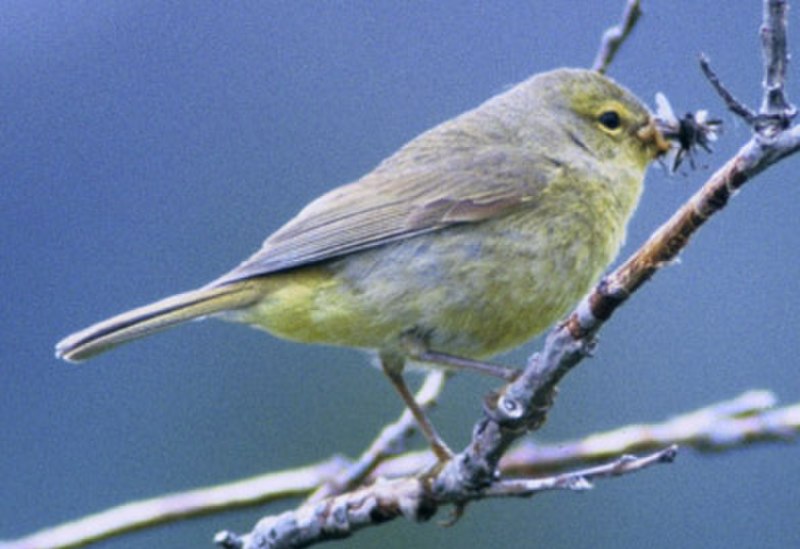
The Orange-crowned Warbler is a small songbird from the New World warbler family. It was formally described in 1822 by Thomas Say, who gave it its scientific name Sylvia celatus – Latin for ‘cloaked’.
This species has an olive green back and wings with yellowish underparts. The males have bright orange crowns during breeding season, which give this bird its namesake.
They can be found mainly in North America but they also migrate to Central America during winter months.
Their diet consists of insects such as butterflies, moths, grasshoppers and beetles; they may also consume fruits occasionally when available.
These birds are relatively quiet except for their mating calls which include whistles or buzzing sounds that last a few seconds long each time.
The Orange-crowned Warbler is one of the most wide spread passerines today due to their hardiness and adaptability; however there remains threat of habitat destruction that could affect many populations negatively if not addressed soon enough.Scientific classification:
| Kingdom | Animalia |
| Phylum | Chordata |
| Class | Aves |
| Order | Passeriformes |
| Family | Parulidae |
| Genus | Leiothlypis |
| Species | L. celata |
Also Featured In: Phoenix Birds You Should Know, Common Birds in Saskatchewan
46. Common Yellowthroat

The Common Yellowthroat is a small, New World Warbler found throughout North America. It has distinctive yellow and black plumage that earned it the nickname “Yellow Bandit” in the Midwest United States.
This species is highly adaptable and can be found inhabiting wetlands, grasslands, shrub-land habitats, as well as suburban areas.
The genus of this bird’s scientific name translates to mean ‘ground’ and ‘small bird’, which are fitting characteristics for such an elusive yet common little creature.
Its diet consists predominantly of insects but may also include other invertebrates like spiders or worms.
Overall the Common Yellowthroat makes an excellent addition to any backyard with its cheerful song.Scientific classification:
| Kingdom | Animalia |
| Phylum | Chordata |
| Class | Aves |
| Order | Passeriformes |
| Family | Parulidae |
| Genus | Geothlypis |
| Species | G. trichas |
Also Featured In: Nebraska Birds, Most Common Songs Birds that Live around You
47. Black-Throated Green Warbler
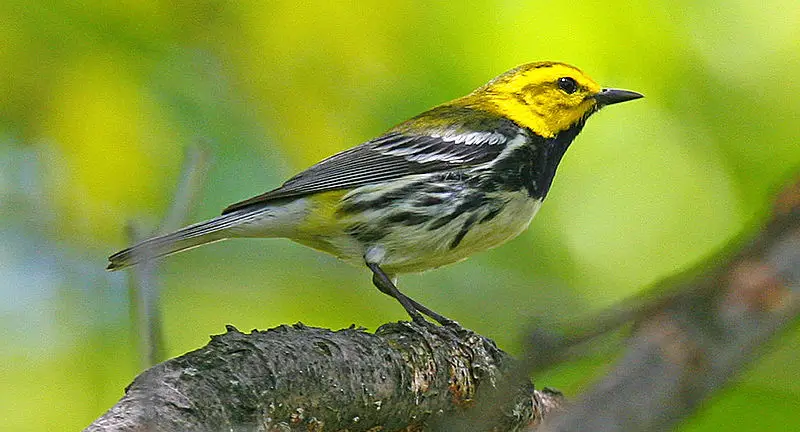
The Black-throated Green Warbler is a beautiful and dainty songbird in the New World warbler family.
It has an olive green crown, yellow face with dark markings, white wing bars and pale underparts streaked with black on the sides.
Adult males have a striking black throat and upper breast while females show paler coloration on their throats but retain some black patterning across their chest area.
They are quite small birds measuring around 14 cm in length from bill to tail tip that make them easy to miss if they aren’t singing.
Their diet consists mainly of insects which they catch by flitting through trees or shrubs as well as foraging among foliage making this species great help in controlling bug populations.Scientific classification:
| Kingdom | Animalia |
| Phylum | Chordata |
| Class | Aves |
| Order | Passeriformes |
| Family | Parulidae |
| Genus | Setophaga |
| Species | S. virens |
Also Featured In: Maine Birds, Birds Commonly Found in New York
48. Northern Parula
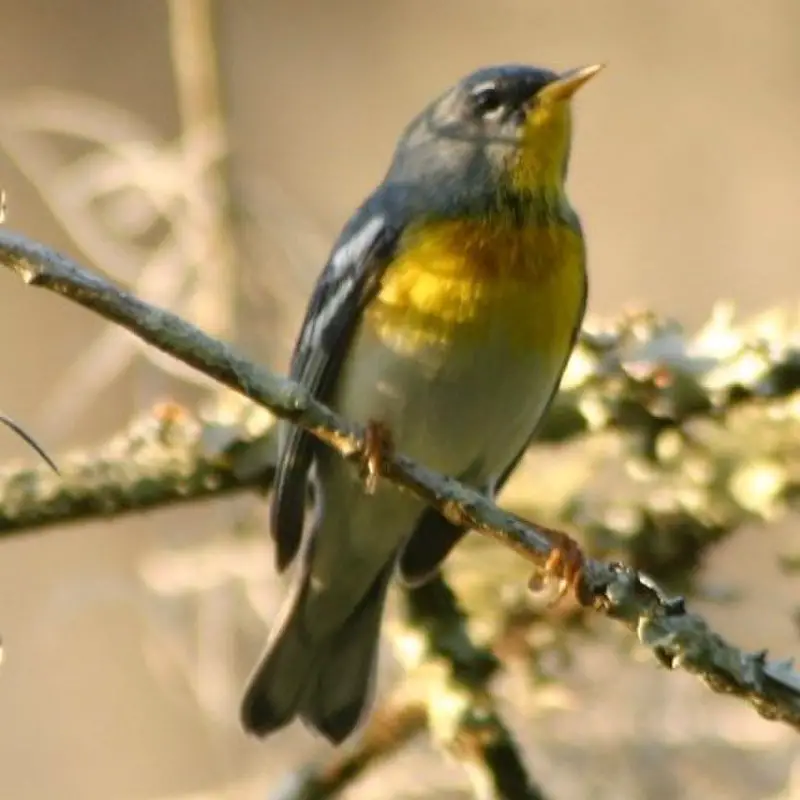
The Northern Parula is a small, migratory warbler native to North America. It measures between 4.3 and 4.9 inches in length and has a wingspan of 6.3-7.1 inches wide.
Its plumage consists mainly of yellowish green upper parts with an orange patch on its chest as well as blue crowns for males during the breeding season.
Females have duller colors than their male counterparts overall but are still quite striking from afar.
This species breeds primarily in eastern Canada down through Florida, though some northern populations may migrate southward come wintertime while others stick around year round depending on the weather conditions they face each year – truly amazing adaptability set them apart from other birds in this region.Scientific classification:
| Kingdom | Animalia |
| Phylum | Chordata |
| Class | Aves |
| Order | Passeriformes |
| Family | Parulidae |
| Genus | Setophaga |
| Species | S. americana |
Also Featured In: Adirondack Mountain Birds, Yellow Birds You’ll Find in Minnesota
49. Summer Tanager
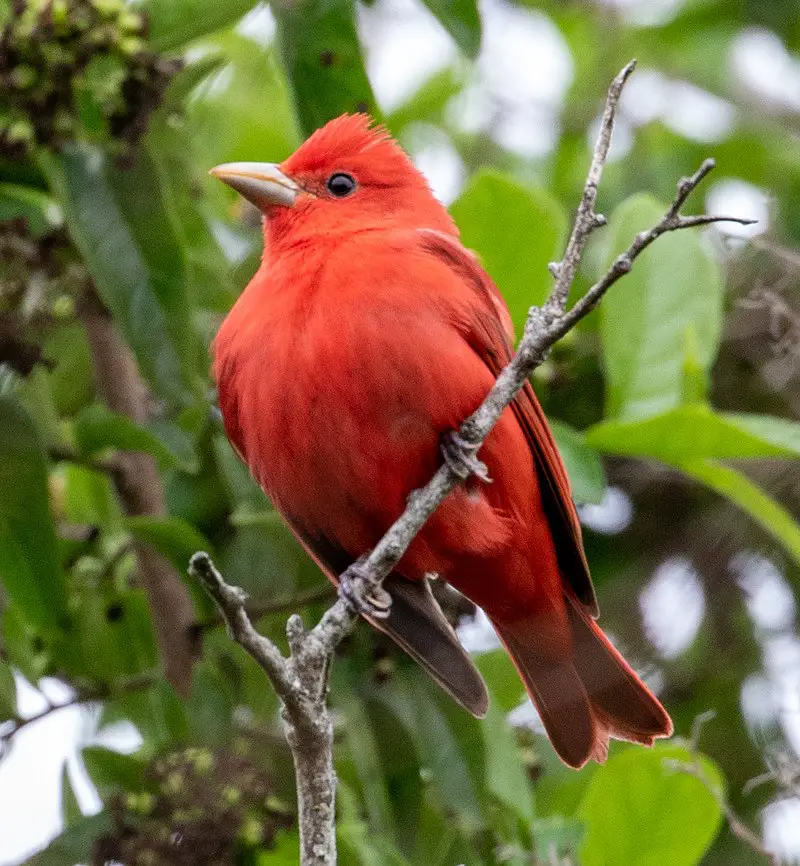
The Summer Tanager is a stunningly beautiful member of the cardinal family. Native to North and South America, this medium-sized songbird features striking red plumage on its back with yellow underparts.
It has a pointed black bill and long tail feathers that can be seen fluttering through the air when it flies.
The species’ vocalizations are quite similar to those of other members of its genus as well, which often include short whistles and chirps in addition to longer songs made up of various phrases or syllables.
With their vibrant colors and melodic voices, these birds make an eye-catching sight any time they appear.Scientific classification:
| Kingdom | Animalia |
| Phylum | Chordata |
| Class | Aves |
| Order | Passeriformes |
| Family | Cardinalidae |
| Genus | Piranga |
| Species | P. rubra |
Also Featured In: birds of Arkansas, Birds Live in Arkansas
50. Verdin
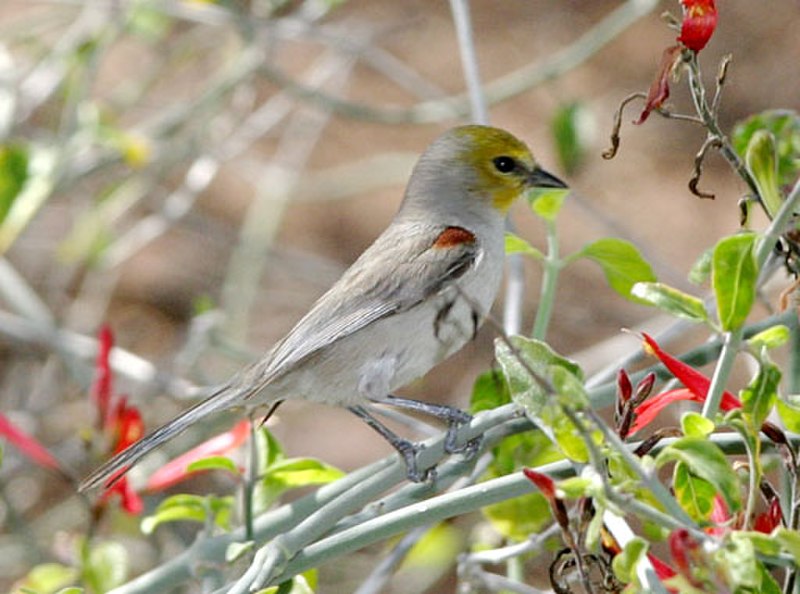
Verdin is a species of penduline tit, the only one in its genus Auriparus and family Remizidae found in North America.
It was formally described by Swedish zoologist Carl Jakob Sundevall under the binomial name Aegithalus flaviceps in 1850.
This small bird has an olive-grey coloration on its head, back and wings while having white colouring around its face with yellowish patches near eyes.
The underside is pale grey with brown tinge while feet are pinkish/brown tinted. Its diet consists mainly of insects which it forages from tree branches or shrubs.
During mating season they build intricate nests made up of grasses and moss lined inside with feathers or fur held together by spider webs usually suspended from thorny trees close to water sources like rivers or streams making them ideal for rearing young chicks before their migration towards south during winter months.Scientific classification:
| Kingdom | Animalia |
| Phylum | Chordata |
| Class | Aves |
| Order | Passeriformes |
| Family | Remizidae |
| Genus | Auriparus S.F. Baird, 1864 |
| Species | A. flaviceps |
Also Featured In: birds of Arizona, Birds that Live in the Deserts
51. Cedar Waxwing
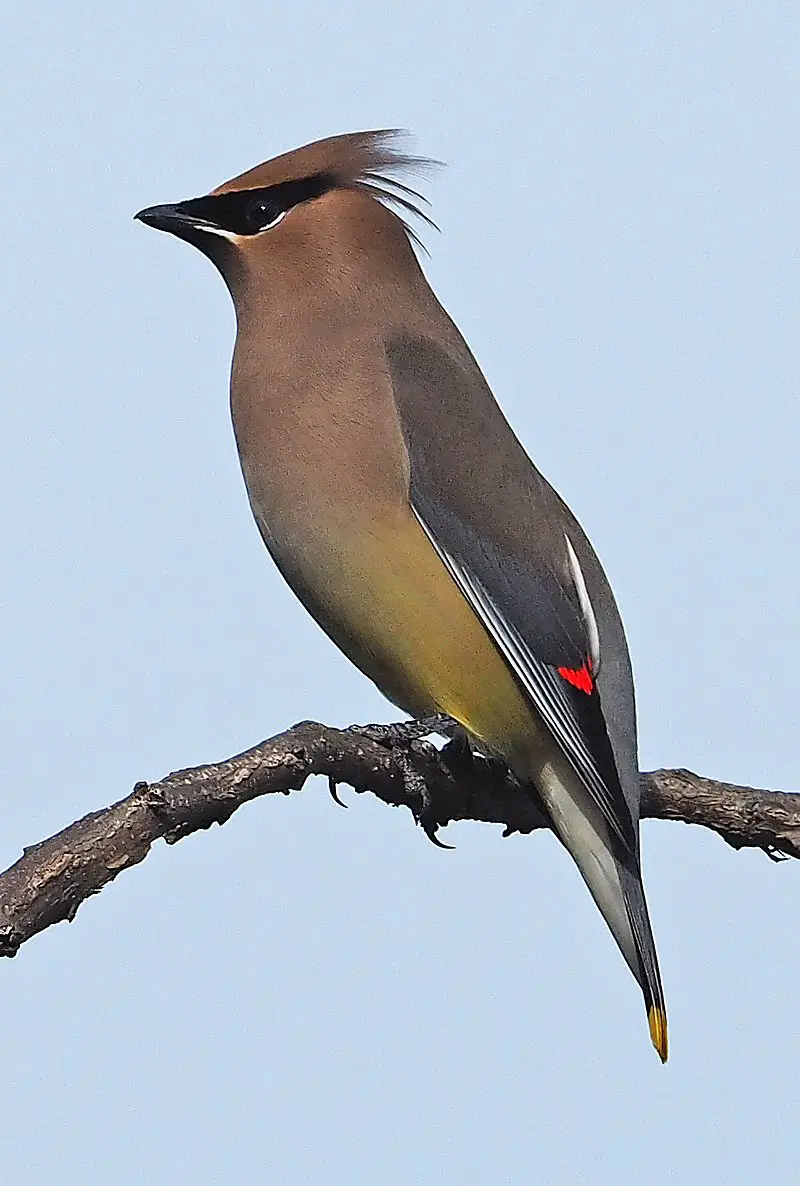
The Cedar waxwing, also known as Bombycilla cedrorum, is a medium-sized bird found in North and Central America.
They have a mixture of brown, gray and yellow feathers on their body, and their wings have wax-like tips.
These birds prefer open wooded areas in Southern Canada for breeding, and during winter, they migrate to the Southern part of the United States, Central America, and the far.
The Cedar waxwing is a member of the waxwing family of birds or Bombycillidae family.
They are known for their distinctive crest on their head and a black mask-like area around their eyes.
These birds are social creatures and can often be seen in large flocks, sometimes even intermixing with other bird species.
Their diet consists mainly of fruit and insects, and they are important dispersers of fruit seeds.
The Cedar waxwing bird is a beautiful and fascinating creature to observe in the wild.Scientific classification:
| Kingdom | Animalia |
| Phylum | Chordata |
| Class | Aves |
| Order | Passeriformes |
| Family | Bombycillidae |
| Genus | Bombycilla |
| Species | B. cedrorum |
Also Featured In: New Hampshire Birds You Should Know, Summer Birds that Live around Us